D Link WA140C1 RangeBooster N USB Adapter User Manual
D Link Corporation RangeBooster N USB Adapter
D Link >
User Manual
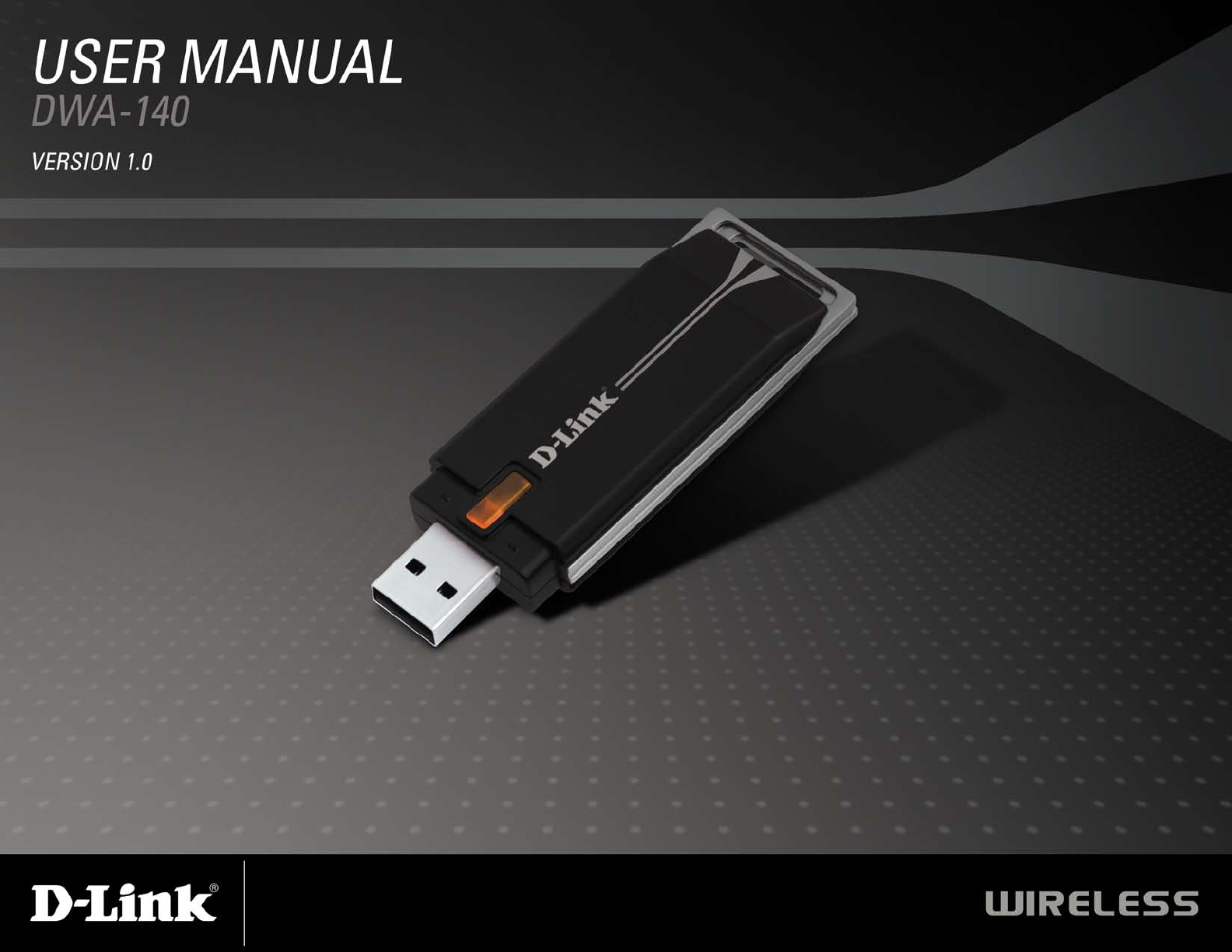

2D-Link DWA-140 User Manual
Table of Contents
Product Overview ........................................................ 3
Package Contents ...................................................3
System Requirements ............................................. 3
Introduction ..............................................................4
Features .................................................................. 5
Hardware Overview ................................................. 6
Installation ....................................................................7
Getting Started ........................................................7
Remove Existing Installations ............................7
Disable Other Wireless Adapters ....................... 8
Adapter Installation ................................................10
Conguration ............................................................. 14
D-Link Wireless Connection Manager ................... 14
Wireless Networks ...........................................15
My Wireless Networks .....................................16
Support ............................................................19
About ............................................................... 20
Windows® XP Conguration Utility ......................... 21
Disabling The Windows® XP Utility .................. 22
Wireless Security.......................................................24
What is WEP? .......................................................24
What is WPA? .......................................................25
Congure WEP ......................................................26
Using the D-Link Wireless Connection
Manager ........................................................... 26
Using the Windows® XP Utility ......................... 28
Congure WPA/WPA2 Passphrase ....................... 30
Using the D-Link Wireless Connection
Manager ........................................................... 30
Using the Windows® XP Utility ......................... 32
Troubleshooting ........................................................ 34
Wireless Installation Considerations ...................... 38
Wireless Basics ......................................................... 39
Networking Basics .................................................... 44
Check your IP address ..........................................44
Statically Assign an IP address ............................. 45
Technical Specications........................................... 46
Contacting Technical Support ................................. 48
Warranty .....................................................................49
Registration ................................................................ 55
Table of Contents
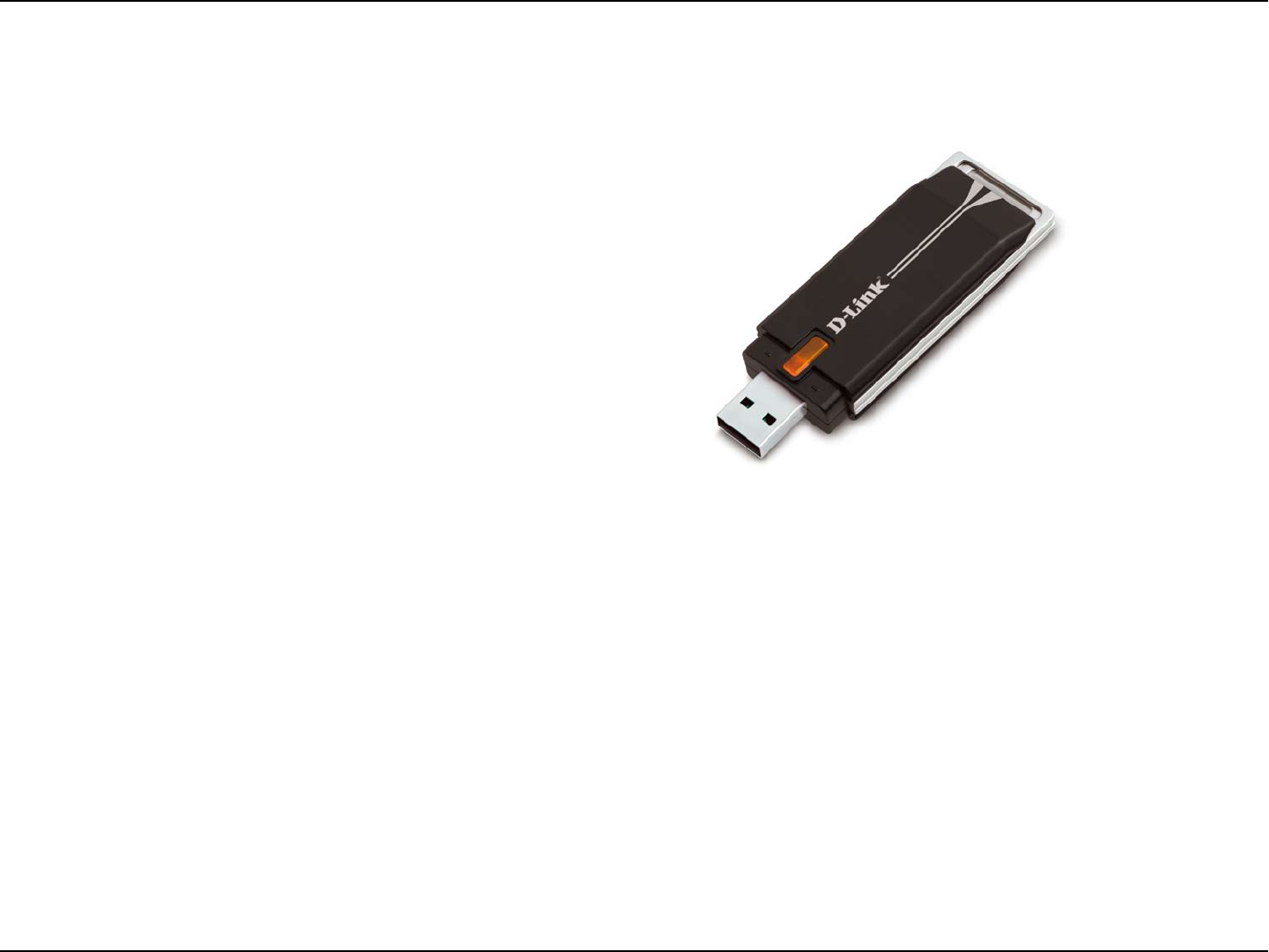
3D-Link DWA-140 User Manual
Section 1 - Product Overview
• D-Link DWA-140 Wireless USB Adapter
• Manual and Warranty on CD
• D-Link Wireless Connection Manager on CD
• Quick Installation Guide
System Requirements
• A computer or laptop with an available USB 2.0 port
• Windows® 2000 (Service Pack 4) or XP (Service Pack 2)
• CD-ROM Drive
• 300MHz processor and at least 64MB of RAM
• A draft 802.11n or 802.11b/g access point (for Infrastructure mode), or another draft 802.11n wireless
adapter (for Ad-Hoc mode.)
Product Overview
Package Contents

4D-Link DWA-140 User Manual
Section 1 - Product Overview
Introduction
The DWA-140 Wireless N™ USB Adapter is a convenient wireless connectivity solution for desktop or notebook PCs.
Instead of stringing Ethernet cables to your PC or dismantling your desktop computer case, the DWA-140 can enable
Draft 802.11n wireless connectivity by simply utilizing your desktop or notebook PC’s USB port.
Powered by Wireless N™ technology, the DWA-140 provides a faster wireless connection and superior reception than
802.11g*. The DWA-140 is designed for use in bigger homes and for those that demand higher networking. Maximize
wireless performance by connecting this USB Adapter to a Wireless N™ Router and stay connected from virtually
anywhere in the home. This USB Adapter supports WEP, WPA and WPA2 encryption to prevent outside intrusion and
protect your personal information from being exposed.
D-Link’s Quick Setup Wizard guides you step-by-step through the installation process. You’ll be able to congure this
USB Adapter without having to call the teenager from down the street to help you. The D-Link Wireless Manager is
included with this product to keep track of all your most frequently accessed networks.
Compact in size, robust in speed the DWA-140 Wireless USB Adapter is great for travel and a convenient solution for
providing high performance wireless connectivity to your desktop or notebook PC. Enjoy the many benets of wireless
connectivity today!
* Maximum wireless signal rate derived from IEEE Standard 802.11g and Draft 802.11n specications. Actual data throughput will vary. Network
conditions and environmental factors, including volume of network trafc, building materials and construction, and network overhead, lower actual
data throughput rate. Environmental conditions will adversely affect wireless signal range.

5D-Link DWA-140 User Manual
Section 1 - Product Overview
Features
• Compact size for placement anywhere.
• Convenience of Plug & Play installation.
• Fully 802.11b/802.11g compatible.
• Draft 802.11n compliant.
• Powered by the USB port; no external power source required.
• USB 2.0 standard*.
• Better Security with 802.1x and WPA - In addition to 64-bit and 128-bit WEP encryption, you can also
securely connect to a wireless network using 802.1x for wireless authentication, as well as WPA (Wi-Fi
Protected Access) providing you a much higher level of security for your data and communication than
has previously been available.
• Position the DWA-140 almost anywhere in your workspace to achieve the best reception possible.
• Supports Infrastructure networks via an access point and Peer-to-Peer communication in Ad-Hoc
mode.
• User-friendly conguration and diagnostic utilities.
* Using a USB 1.1 port will adversely affect throughput.
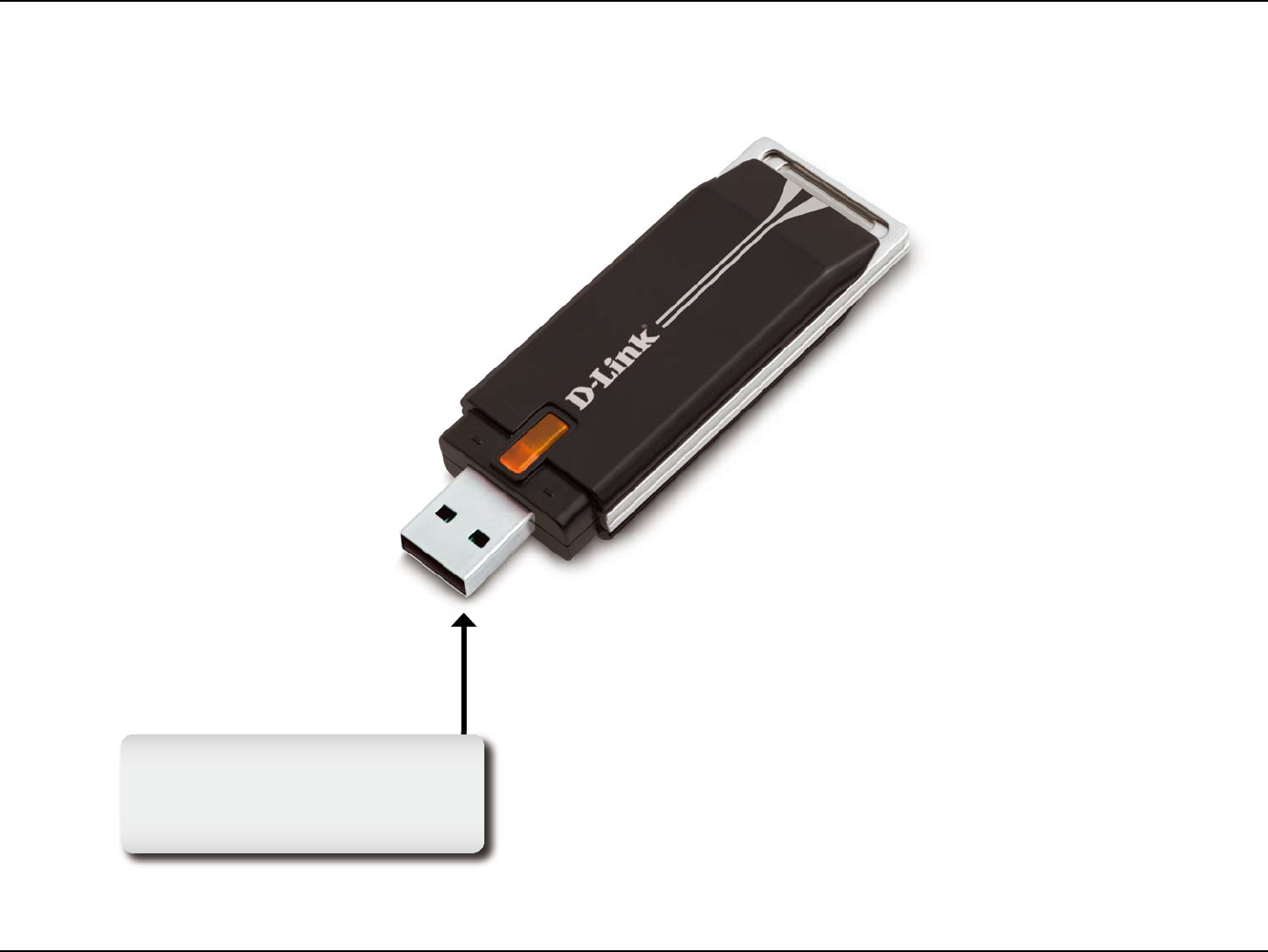
6D-Link DWA-140 User Manual
Section 1 - Product Overview
Hardware Overview
USB Port
Used to connect the DWA-140
to your computer.

7D-Link DWA-140 User Manual
Section 2 - Installation
Getting Started
Installation
This section will walk you through the installation process. If you have a built-in wireless adapter, please disable it in
device manager before installing your D-Link adapter. Also, if you have previously installed another wireless adapter,
please make sure any software is uninstalled.
Before installing your new D-Link wireless adapter, please verify the following:
• Remove any previous installations of wireless adapters
• Disable any built-in wireless adapters
• Verify the settings such as the SSID and security settings of the network(s) you want to connect to
Remove Existing Installations
If you’ve installed a different manufacture’s adapter or a different model D-Link adapter, make sure the software is
uninstalled before installing the new software. Some utilities may cause a conict with the new software. If you plan
to use multiple adapters at different times, make sure the utilities are not set to load when your computer boots up.
Windows® XP users may use the built-in wireless utility for all adapters.
To remove any old software:
Windows® XP users: Click Start > Control Panel > Add or Remove Programs.
Windows® 2000 users: Click Start > Settings > Control Panel > Add or Remove Programs.
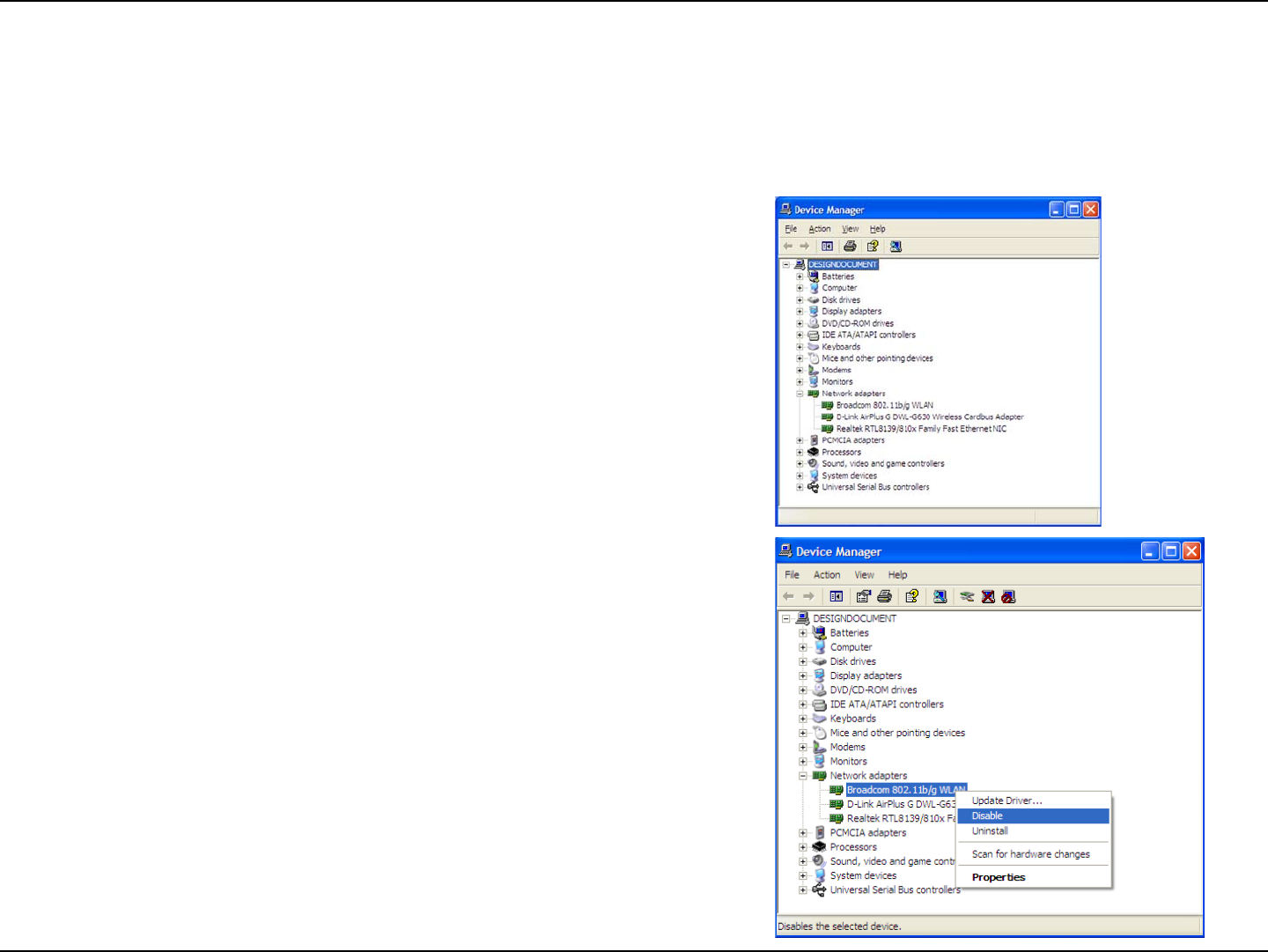
8D-Link DWA-140 User Manual
Section 2 - Installation
Disable Other Wireless Adapters
Most newer laptops may include a built-in wireless adapter. To prevent any conicts with the D-Link wireless adapter,
it is recommended to disable the wireless adapter (as well as any unused Ethernet adapters).
From the desktop, right-click on the My Computer icon and select
Properties.
Click the Hardware tab and then click Device Manager. Scroll down
the list and click the + sign to the left of Network Adapters.
Right-click the adapter you would like to disable and select
Disable.
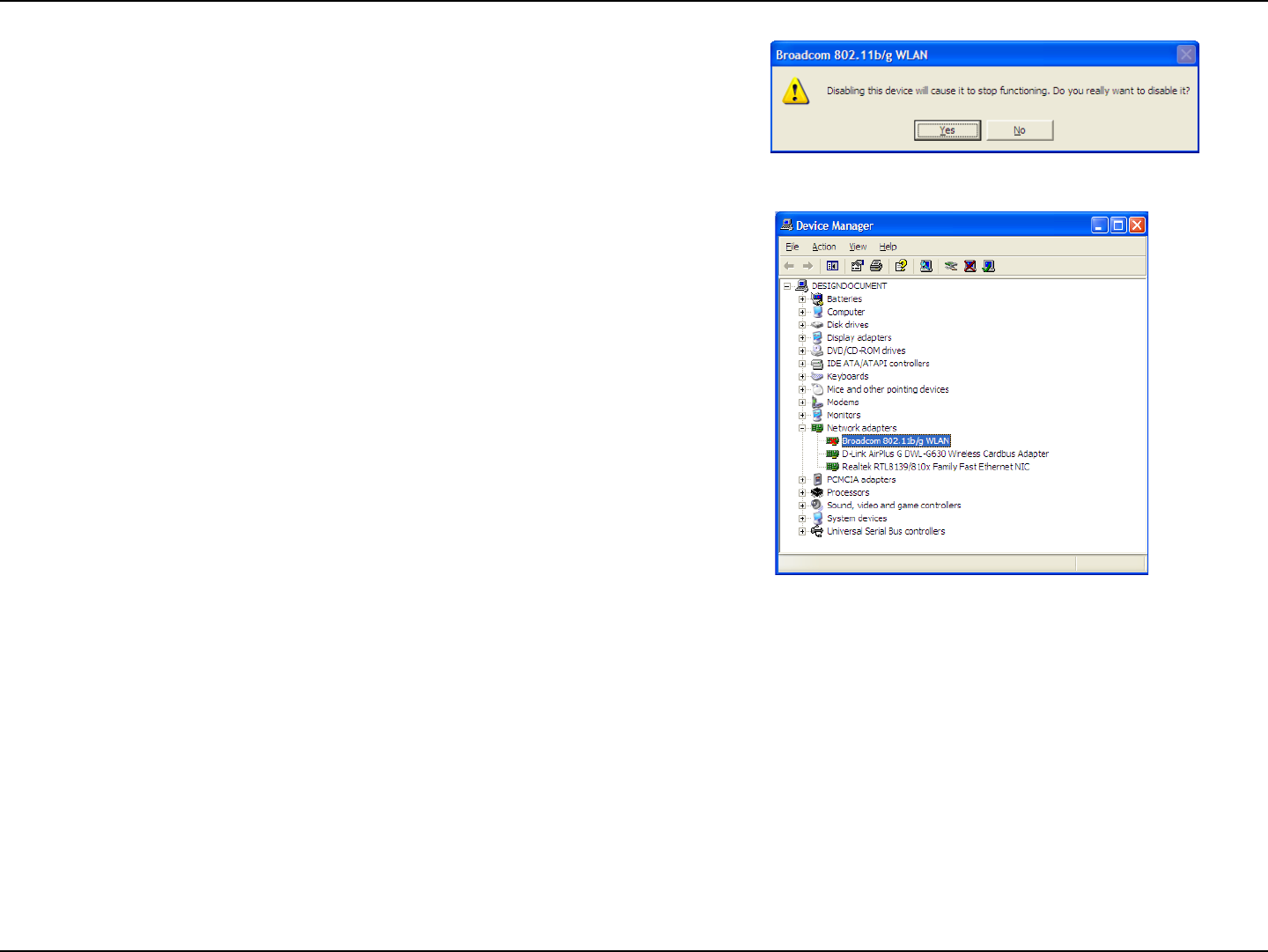
9D-Link DWA-140 User Manual
Section 2 - Installation
Click Yes to disable the adapter.
The adapter is now disabled. When disabled, a red X will be
displayed.
Disabling the adapter will not remove the drivers. If you would like
to use the adapter, simply right-click it and select Enable.

10D-Link DWA-140 User Manual
Section 2 - Installation
Warning: Do NOT install the DWA-140 USB Adapter into your computer before installing the driver software
from the D-Link CD.
Turn on the computer and Insert the D-Link DWA-140 Driver CD in the CD-ROM drive. The step-by-step instructions
that follow are shown in Windows XP. The steps and screens are similar for the other Windows operating systems.
If the CD Autorun function does not automatically start on your computer, go to Start > Run. In the run box type
“D:\DWA-140.exe” (where D: represents the drive letter of your CD-ROM drive).
When the autorun screen appears, click Install Drivers.
Adapter Installation
Click Install Drivers
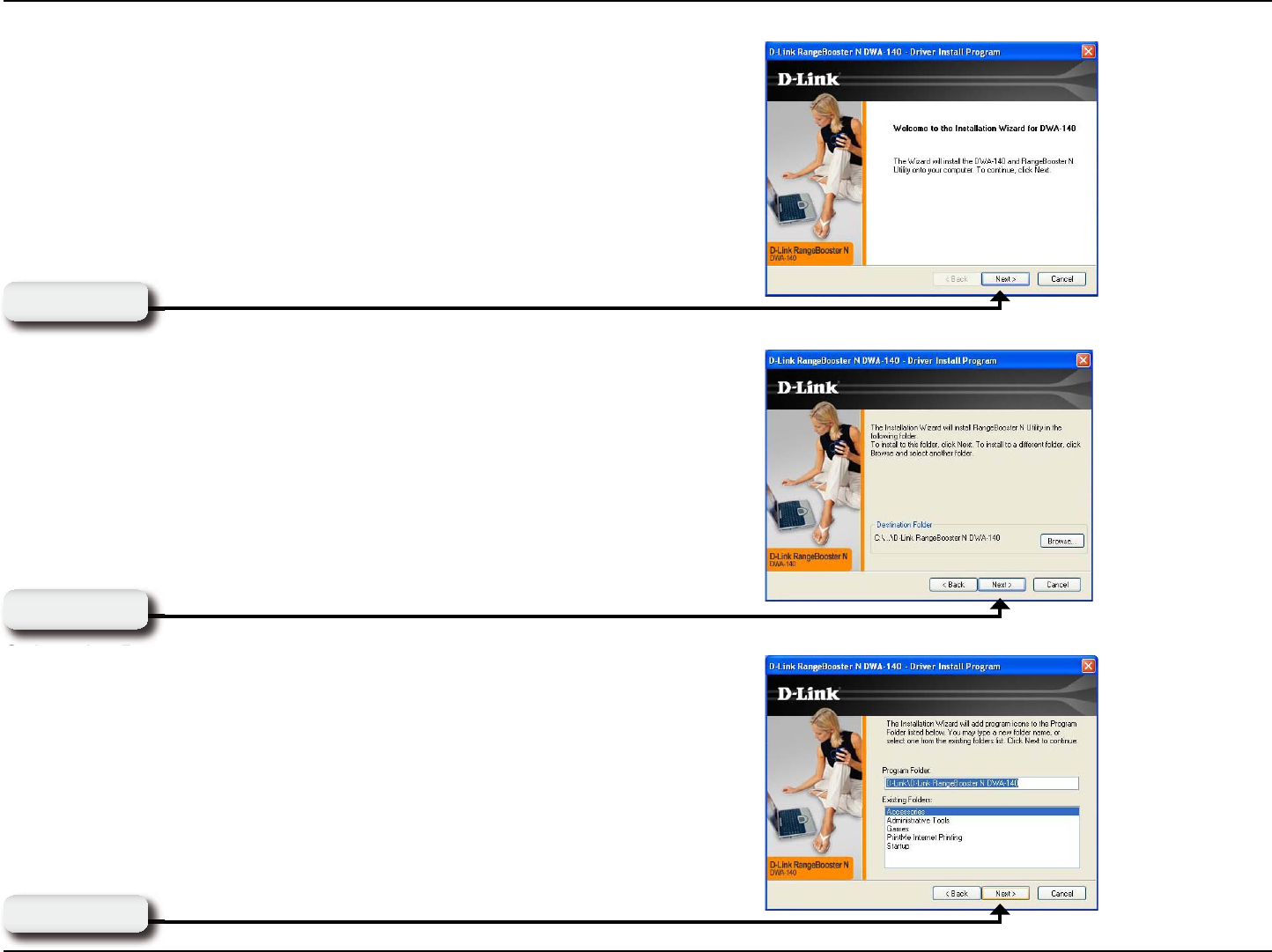
11D-Link DWA-140 User Manual
Section 2 - Installation
The InstallShield Wizard window will appear.
By default setup will install to the default location: C:\Program
Files\D-Link\DWA-140, where C: represents the drive letter of
your hard drive. To install to a different location click Browse
and specify the location.
Select the Program Files folder location.
Click Next
Select the Program Files folder location.
Click Next
Click Next
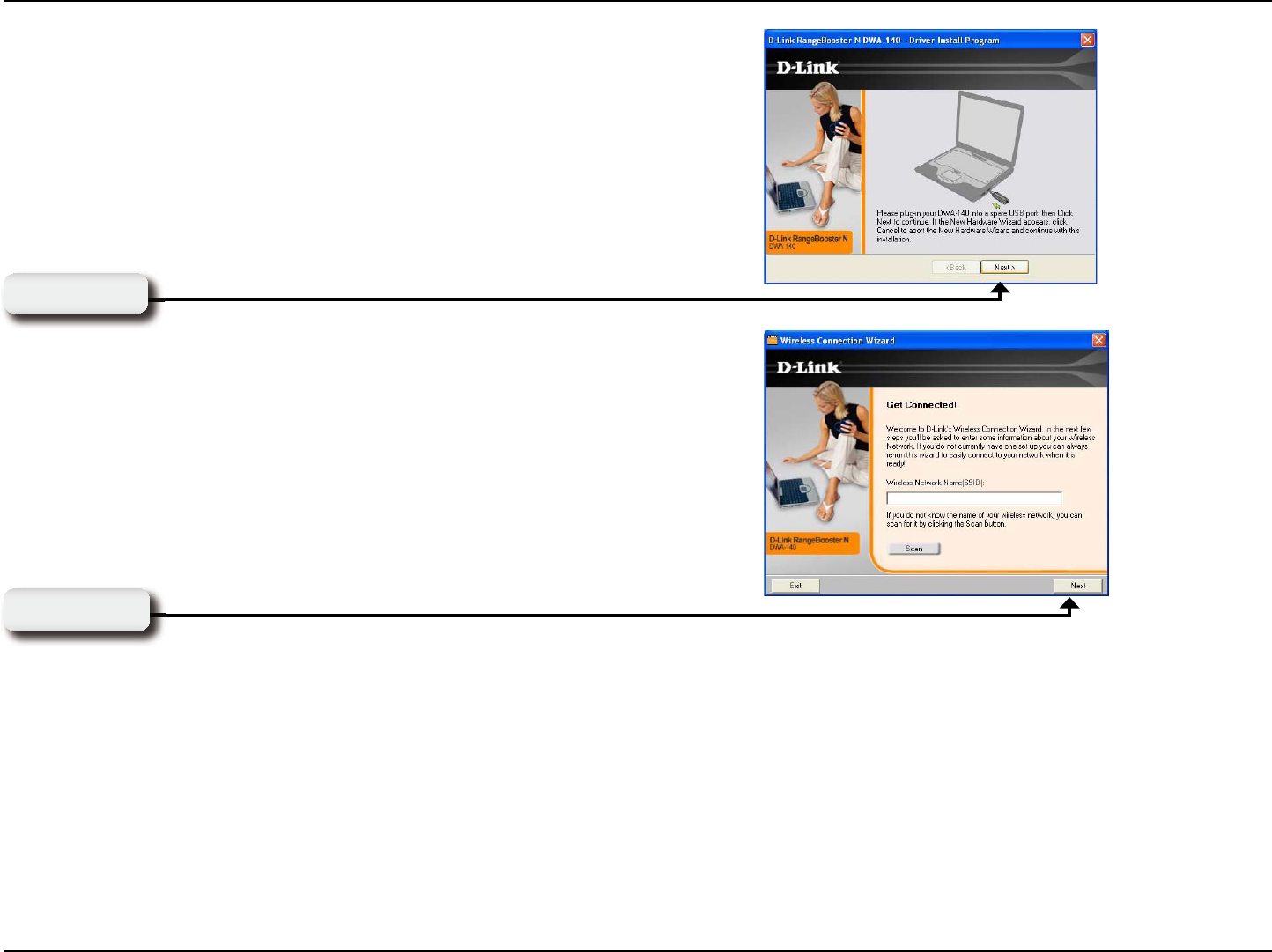
12D-Link DWA-140 User Manual
Section 2 - Installation
Insert the adapter into an available USB port on your
computer.
If the Found New Hardware Wizard appears, click Cancel.
Enter the network name (SSID) manually. If you enter the
SSID incorrectly, you will automatically be brought to the site
survey page. Click Scan to display the site survey page.
Click Next
Click Next
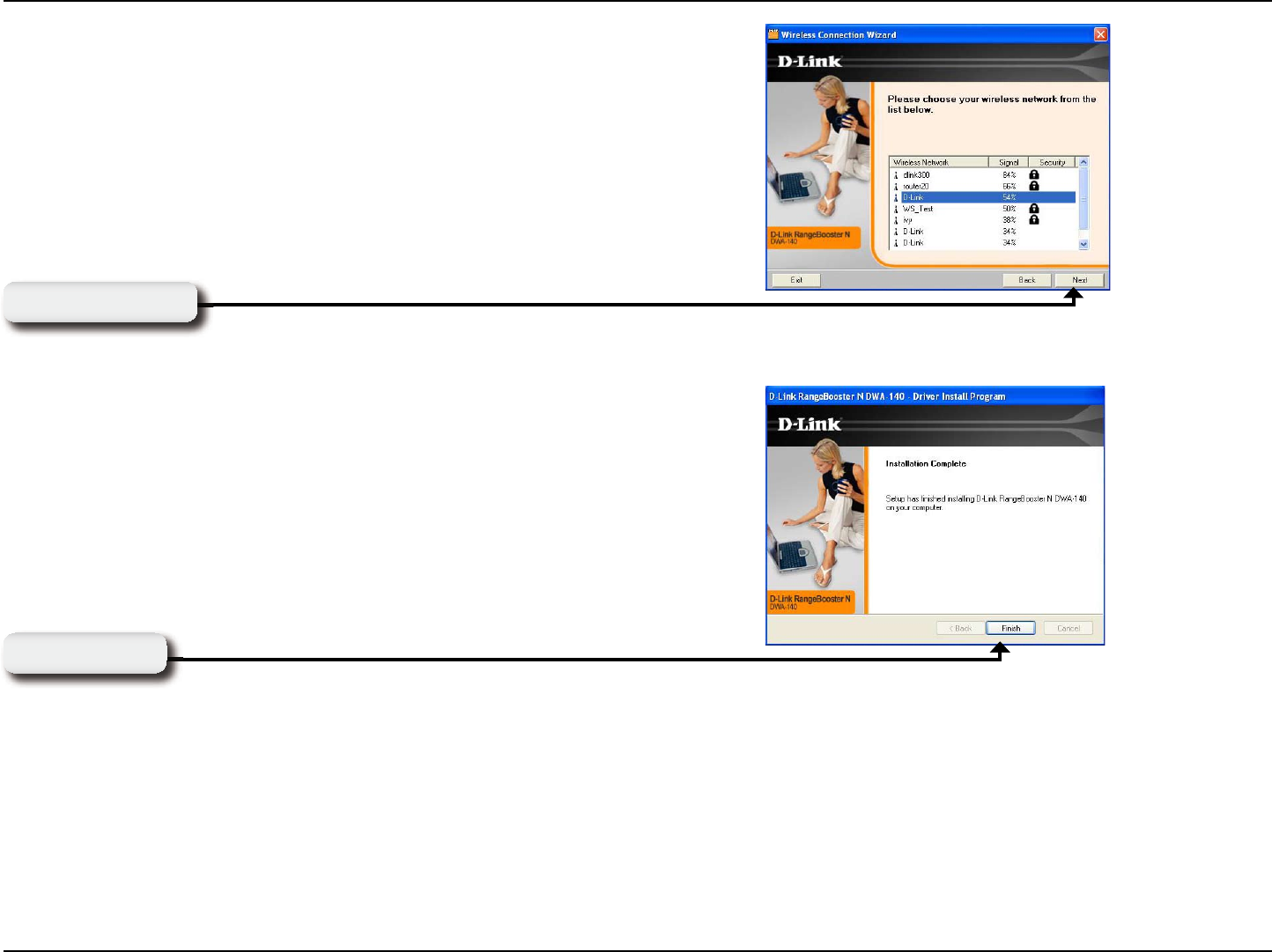
13D-Link DWA-140 User Manual
Section 2 - Installation
Click the Scan button to display a list of wireless networks
(site survey). Click on the network name (SSID) and click
Connect.
Click Finish to continue. If you are prompted to reboot your
Installation Complete.
Click Connect
Click Finish
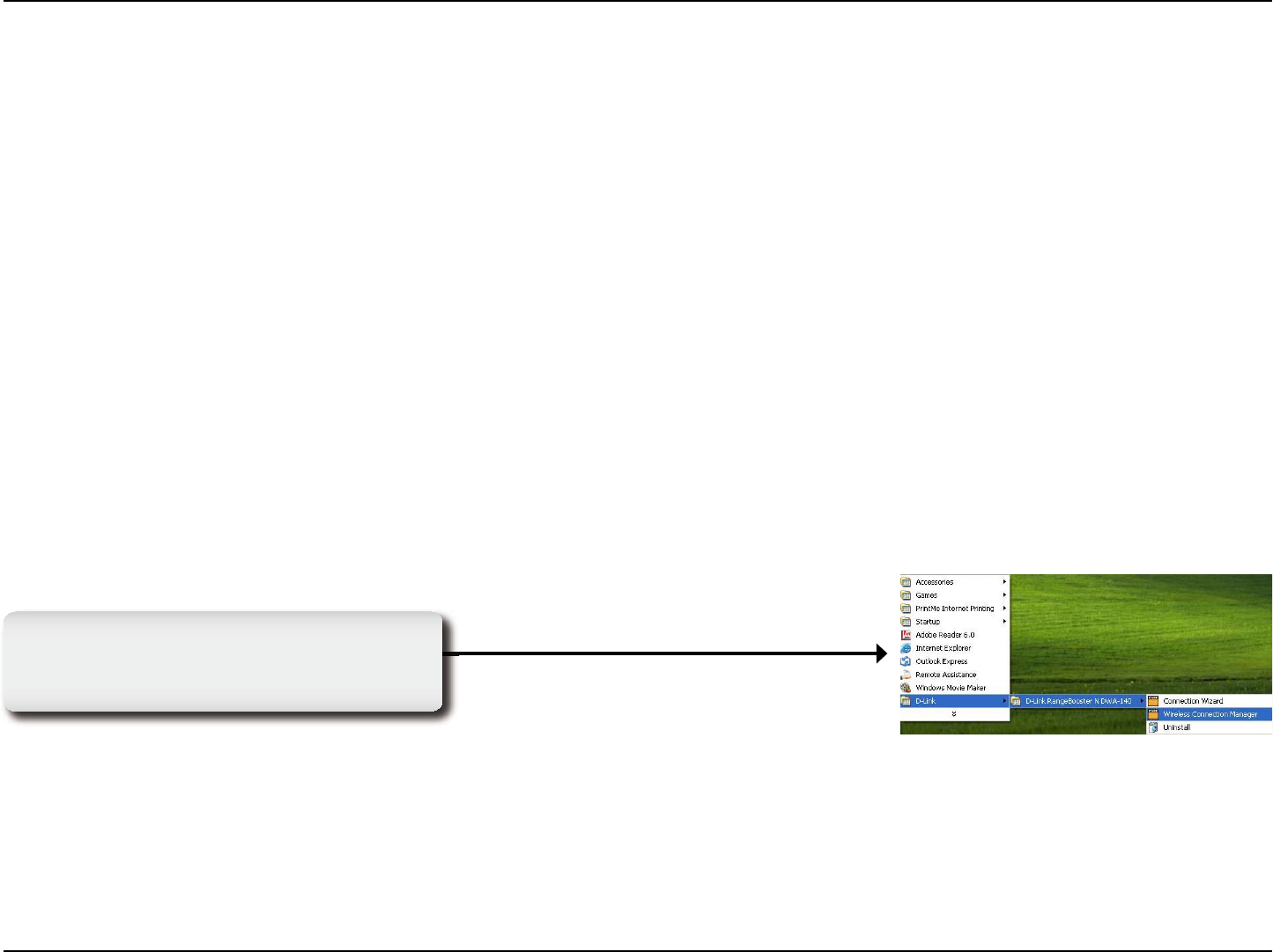
14D-Link DWA-140 User Manual
Section 3 - Configuration
Confi guration
This section will show you how to configure your new D-Link wireless adapter using the D-Link Utility as well as the
Windows® XP Zero Confi guration Utility.
D-Link Wireless Connection Manager
The D-Link DWA-140 uses the Wireless Connection Manager as the management software. The manager provides
the user an easy interface to change any settings related to the wireless adapter. Click -> Start -> Programs -> D-Link
-> D-Link RangeBooster N DWA-140 -> Wireless Connection Manager
If you are using Windows® XP, please skip to page 22.
Click -> Start -> Programs -> D-Link ->
D-Link RangeBooster N DWA-140 ->
Wireless Connection Manager
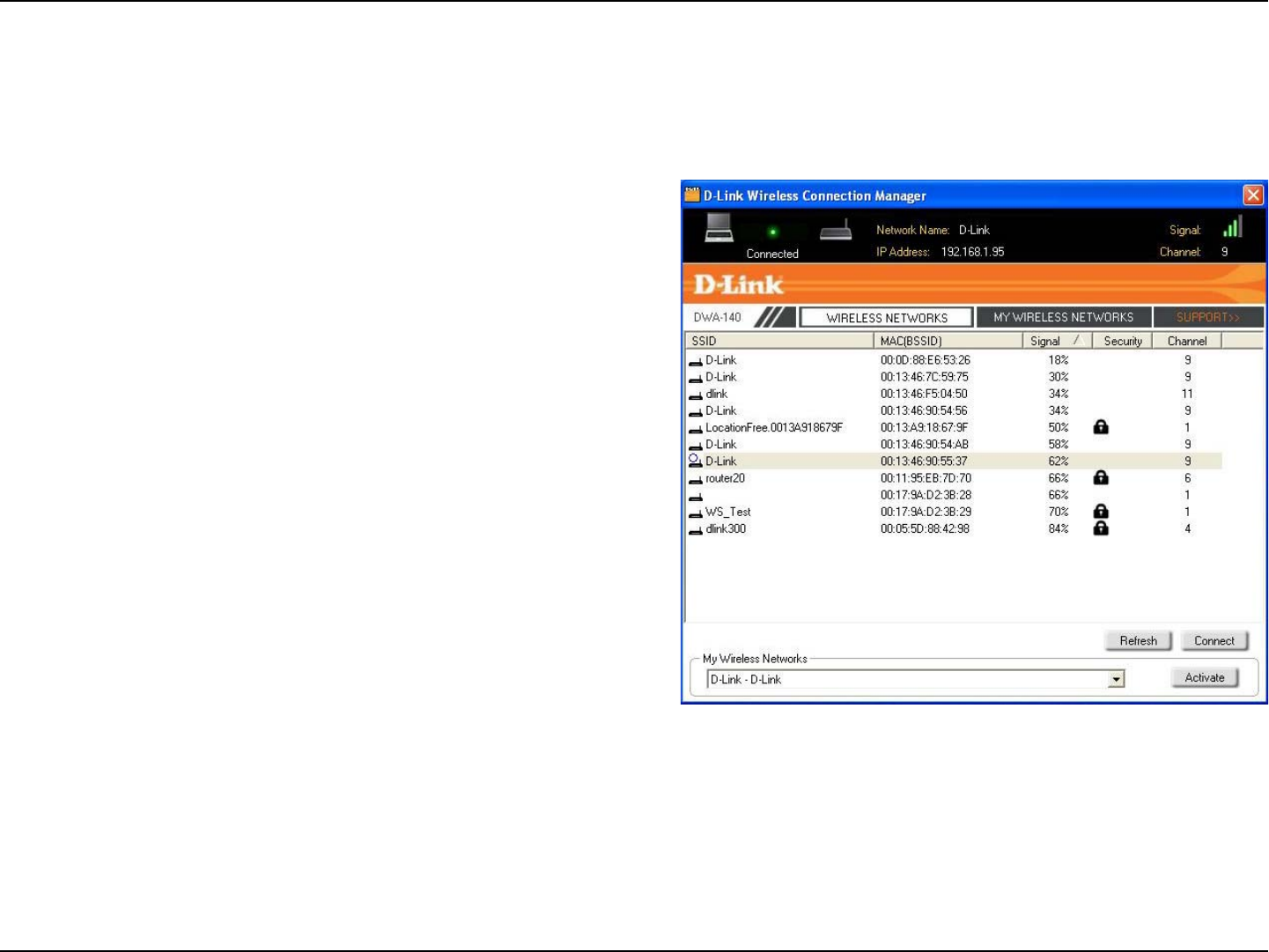
15D-Link DWA-140 User Manual
Section 3 - Configuration
Wireless Networks
The SSID (Service Set Identier) is the name
of the wireless network.
Displays the MAC address of the wireless
device.
Displays the Link Quality of the wireless
connection.
If there is a “lock” icon, this means the wireless
network is secure. You must know the encryption
key/security settings to connect.
Displays the channel of the wireless network.
Rescans for available wireless networks in your
area.
Highlight a wireless network and click the
Connect button. If the network is secure, a
pop-up window will appear. Enter the security
information to connect (refer to the Wireless
Security section for more information).
Select a wireless network profile from the
drop-down menu and click Activate to connect.
Allow up to 30 seconds to connect.
MAC:
SSID:
Channel:
Signal:
Security:
Refresh Button:
Connect Button:
Activate Button:
The Wireless Networks (Site Survey) page will display all wireless networks that are available in your area. To connect
to a network, simply highlight the wireless network (SSID) and click Connect.
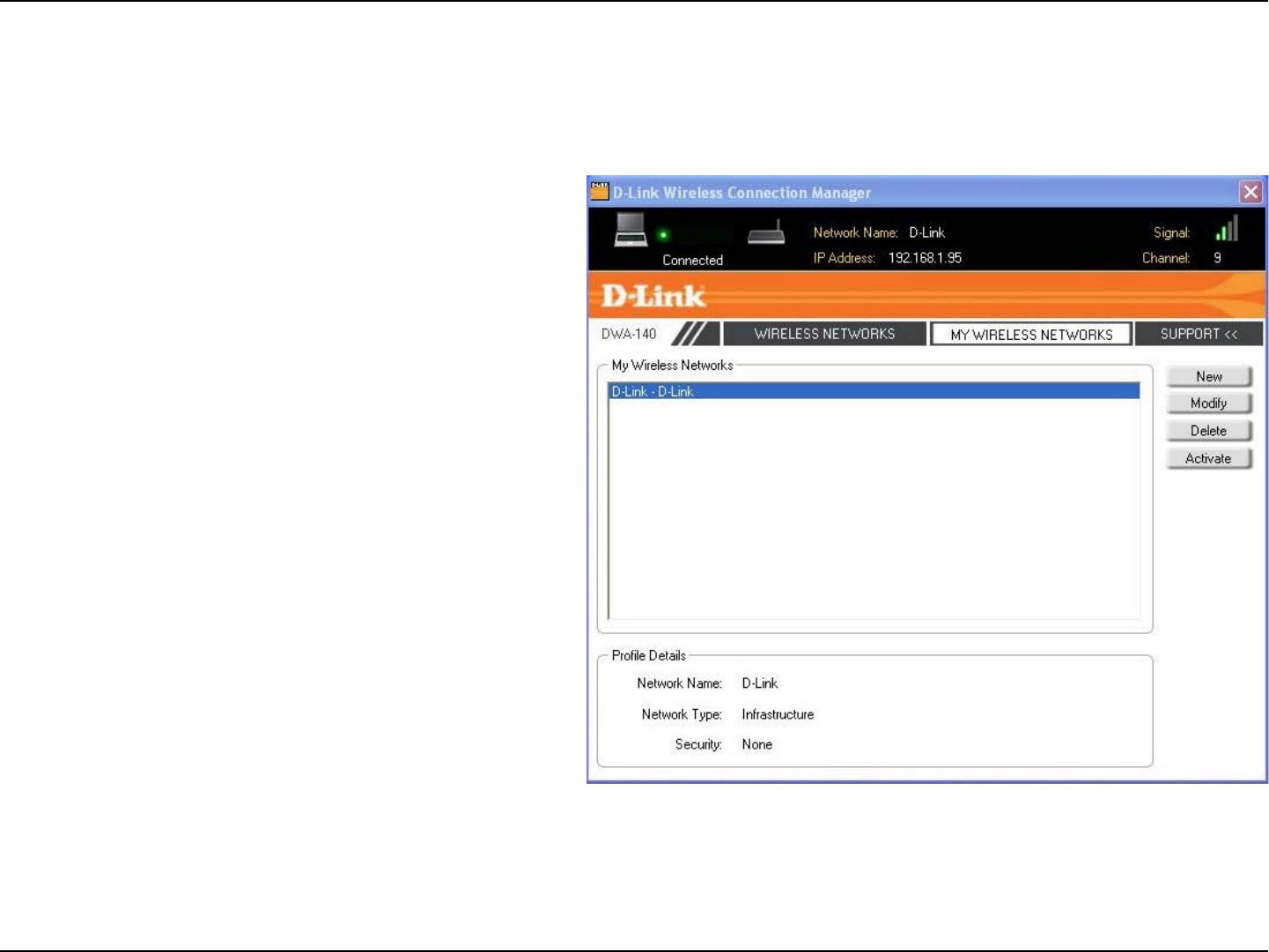
16D-Link DWA-140 User Manual
Section 3 - Configuration
My Wireless Networks
The My Wireless Networks page will allow you to create, edit, and delete wireless network proles. Every time you
connect to a network using the Wireless Networks page, a prole will automatically be created.
New Button:
Modify:
Click New to create a new wireless network
prole (refer to page 18).
Click Modify to edit a current prole (refer to
page 19).
Click Delete to remove a prole.
Click Activate to use a prole. Allow up to 30
seconds to connect to the wireless network.
The Prole Details section will display information
about the wireless network such as the network
name (SSID), network type (Infrastructure or
Ad-Hoc), and if the network is secured.
Delete:
Active:
Profile Details:
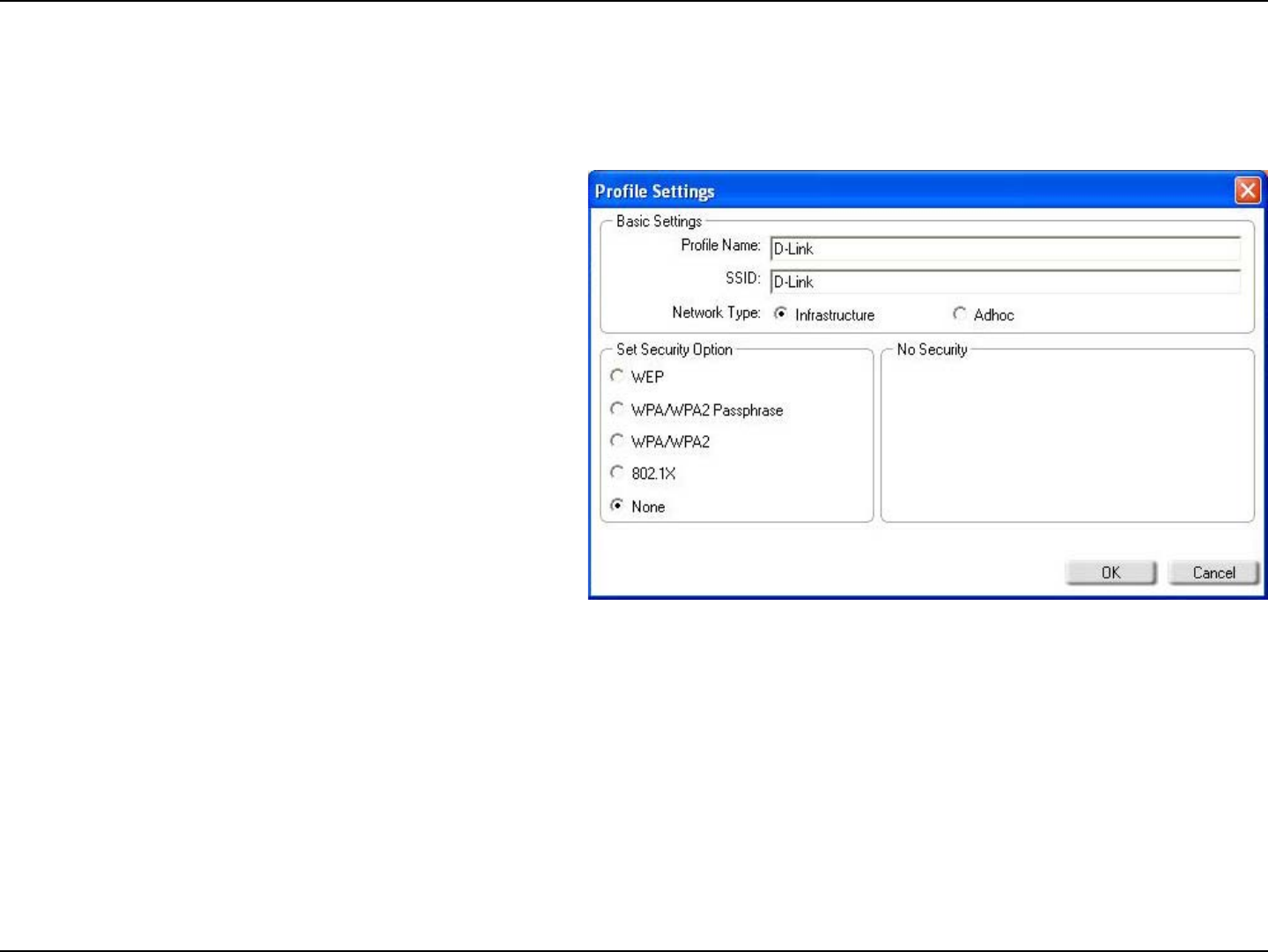
17D-Link DWA-140 User Manual
Section 3 - Configuration
Add Profile
You may add a new network by clicking the New button from the My Wireless Networks page.
Profile Name:
SSID:
Enter a name for your prole (e.g. Home, Ofce,
Coffee Shop).
Enter the SSID of the wireless network.
Select the network type. If you are connecting
to a wireless router or access point, select
Infrastructure. If you are connecting to another
wireless client such as an adapter, select
Ad-Hoc.
Select the type of security used. Please refer
to the Wireless Security section for more
information.
Click OK to save your settings.
Network Type:
Set Security:
OK Button:
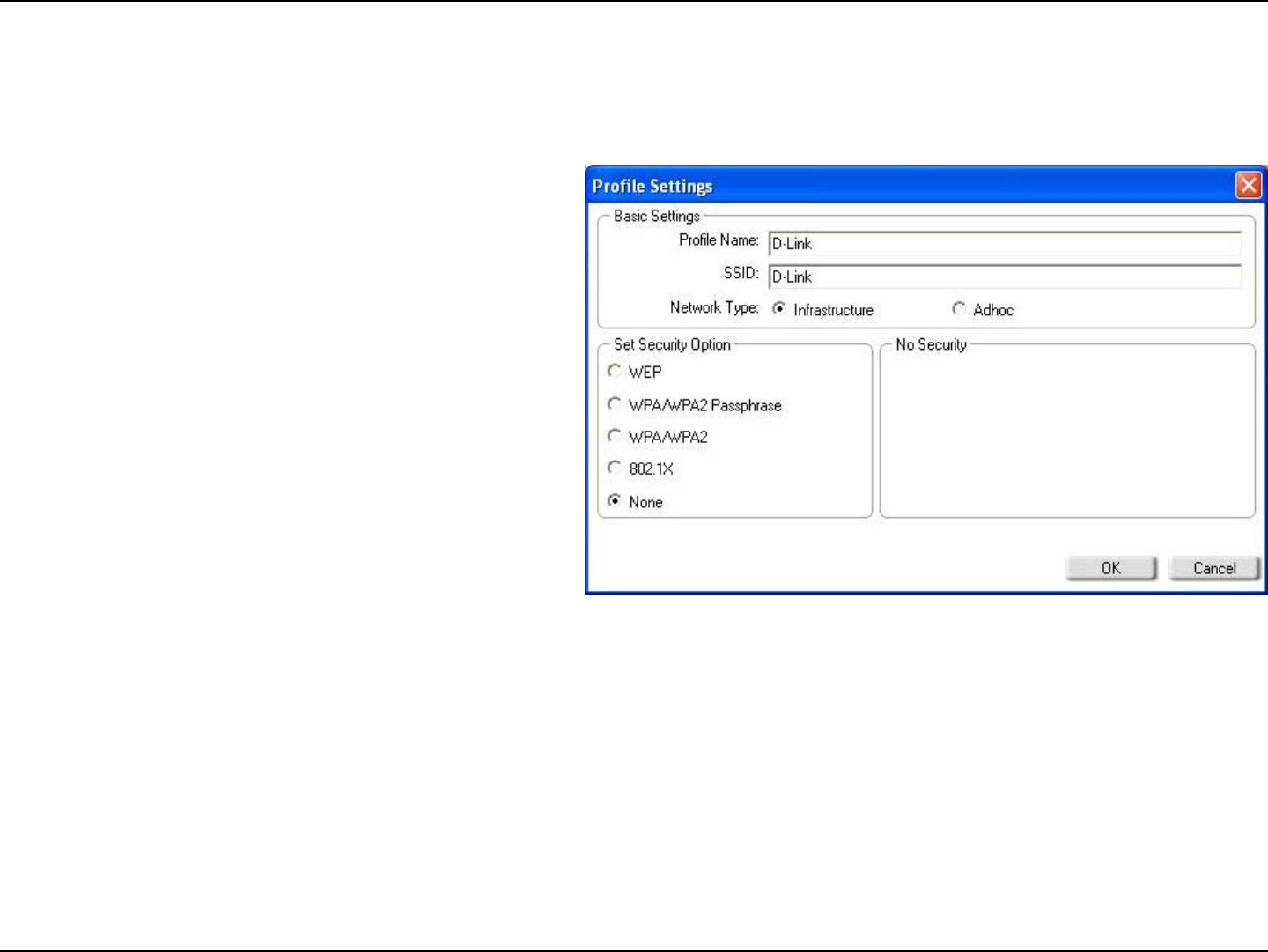
18D-Link DWA-140 User Manual
Section 3 - Configuration
Modify Profile
You may edit an existing prole by clicking the Modify button from the My Wireless Networks page.
Profile Name:
SSID:
Enter a name for your prole (e.g. Home, Ofce,
Coffee Shop).
Displays the SSID of the network.
Displays the network type.
Select the type of security used. Please refer
to the Wireless Security section for more
information.
Click OK to save your settings.
Network Type:
Set Security:
OK Button:
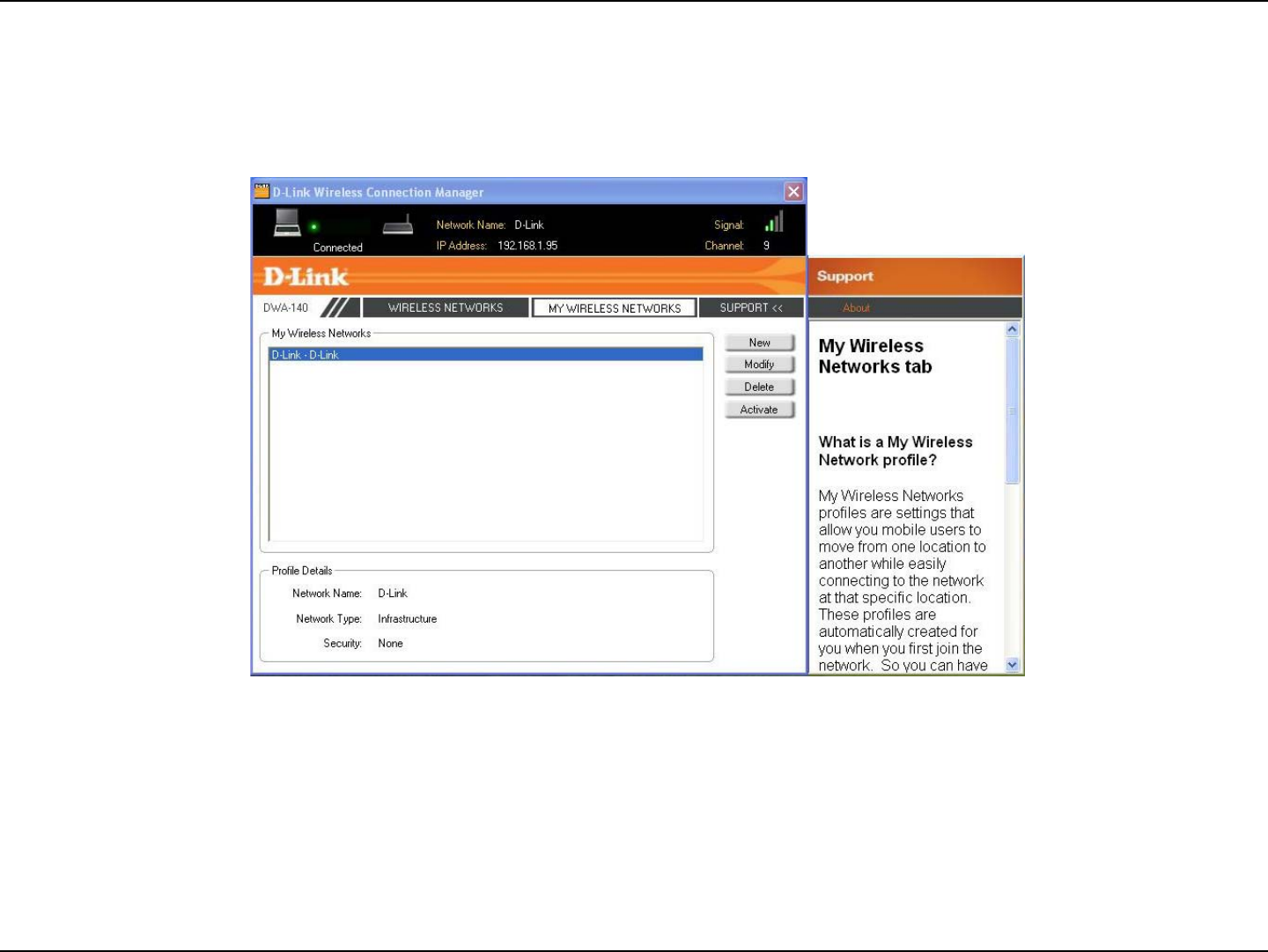
19D-Link DWA-140 User Manual
Section 3 - Configuration
Support
If you need help, click the Support button. A panel will appear to the right of the utility which will display information
about the utility.
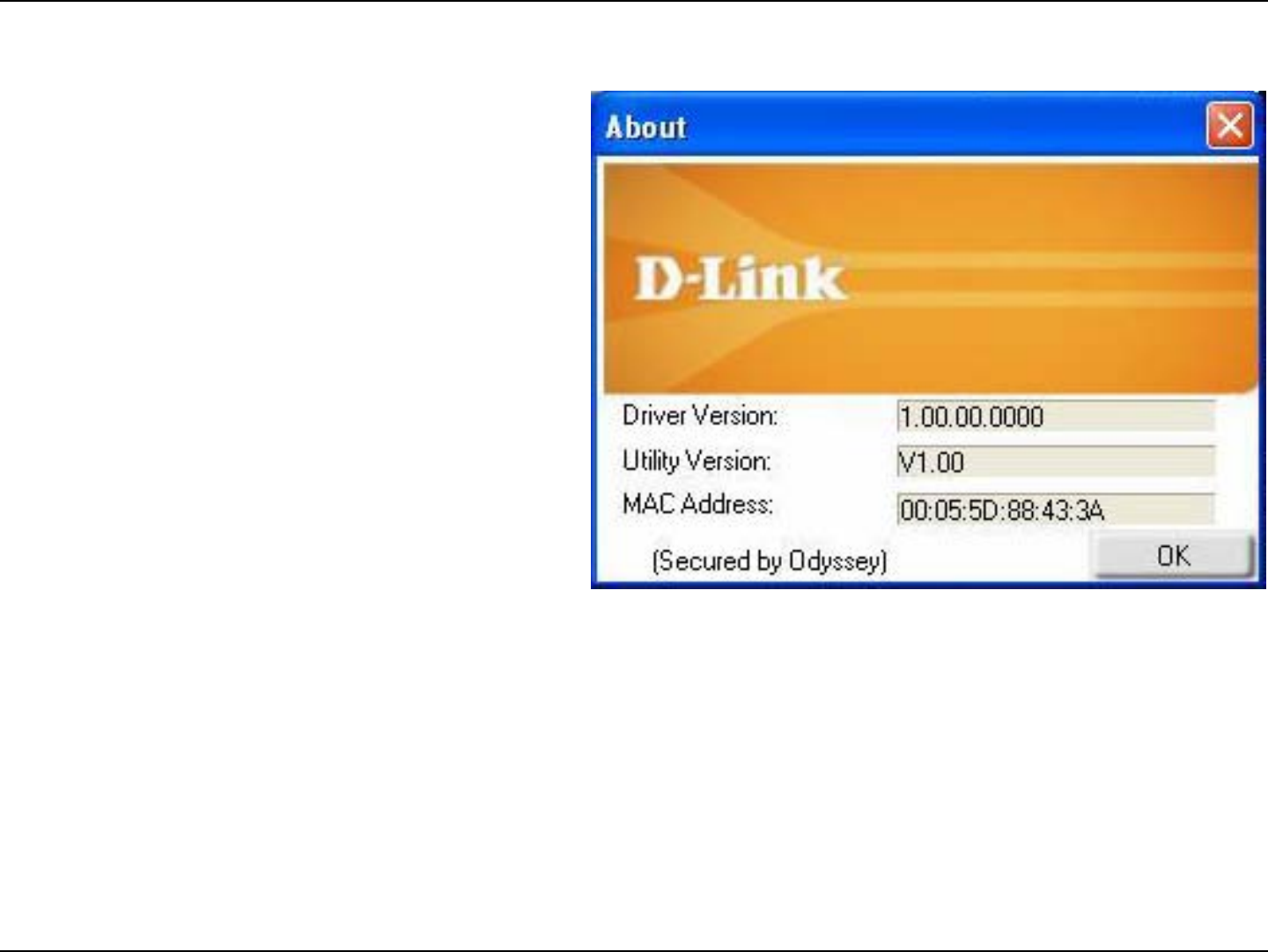
20D-Link DWA-140 User Manual
Section 3 - Configuration
The About screen gives you information about the
Firmware and Utility Versions of the DWA-140.
About
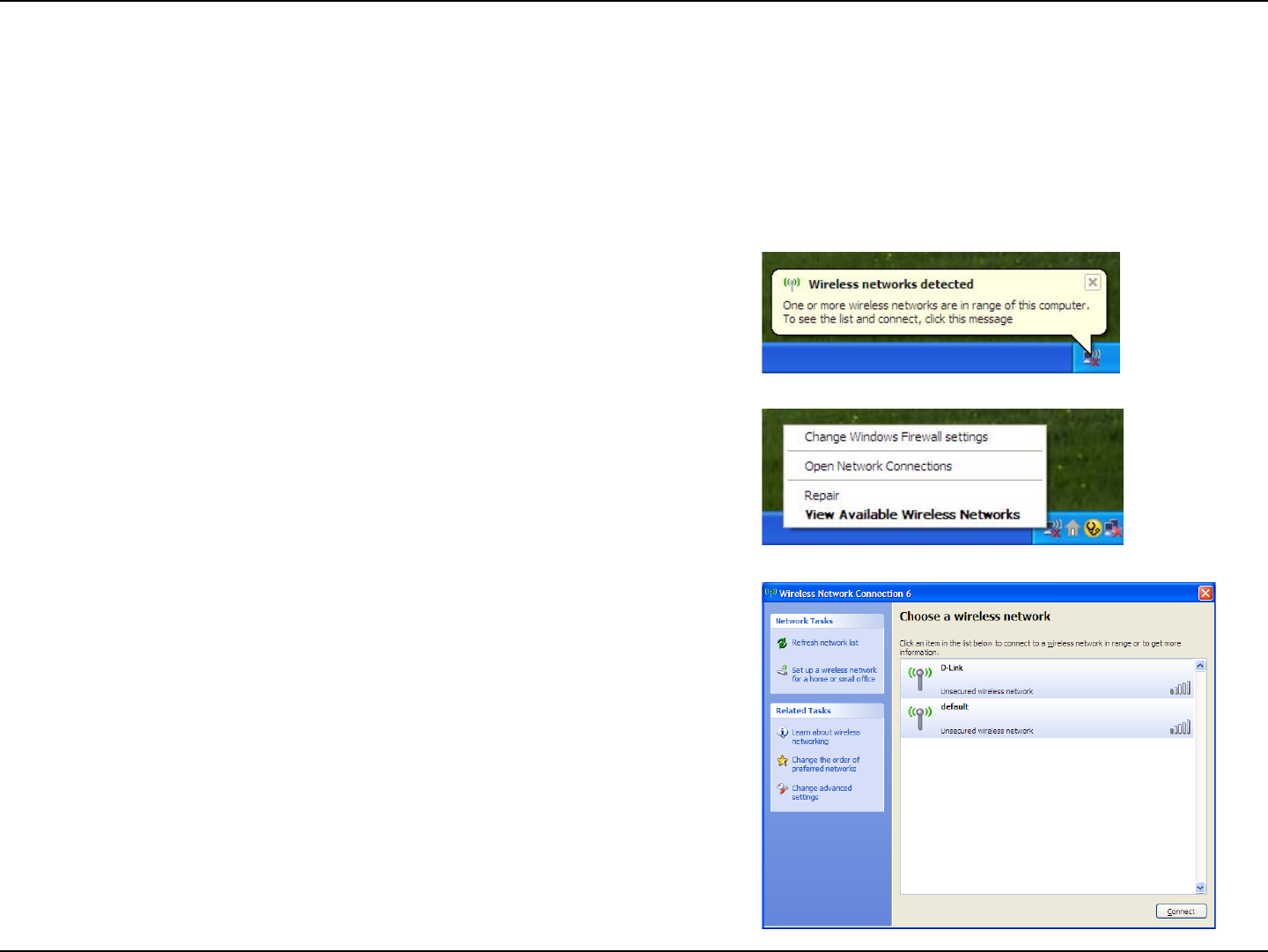
21D-Link DWA-140 User Manual
Section 3 - Configuration
Windows® XP Configuration Utility
Windows® XP users may use the built-in wireless utility. The following instructions are for Service Pack 2 users.
If you are using Windows® 2000, you must use the D-Link utility. Please refer to page 15.
Right-click on the wireless computer icon in your system tray
(lower-right corner next to the time). Select View Available
Wireless Networks.
If you receive the Wireless Networks Detected bubble, click
on the center of the bubble to access the utility.
The utility will display any available wireless networks in your
area. Click on a network and click the Connect button.
Refer to the Wireless Security section for information on
connecting to a secure network.
If you want to use the D-Link utility instead of the Windows® XP
wireless utility, refer to the next page.
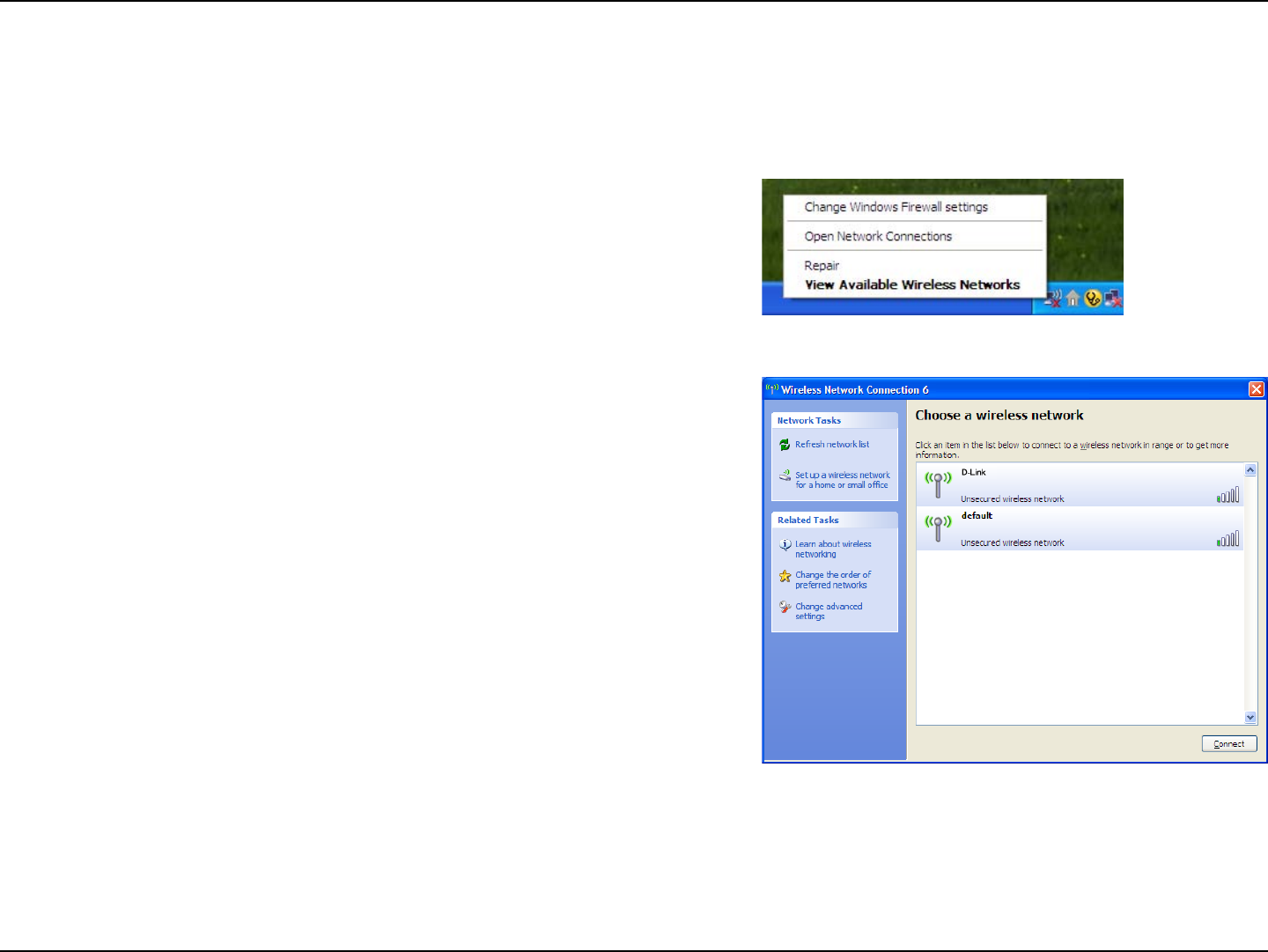
22D-Link DWA-140 User Manual
Section 3 - Configuration
Disabling The Windows® XP Utility
If you want to use the D-Link Wireless Connection Manager you must disable the Windows® XP wireless utility.
Right-click on the wireless computer icon in your system tray
(lower-right corner next to the time). Select View Available
Wireless Networks.
In the Choose a Wireless Network window click Change
Advanced Settings on the left side below Related Tasks.
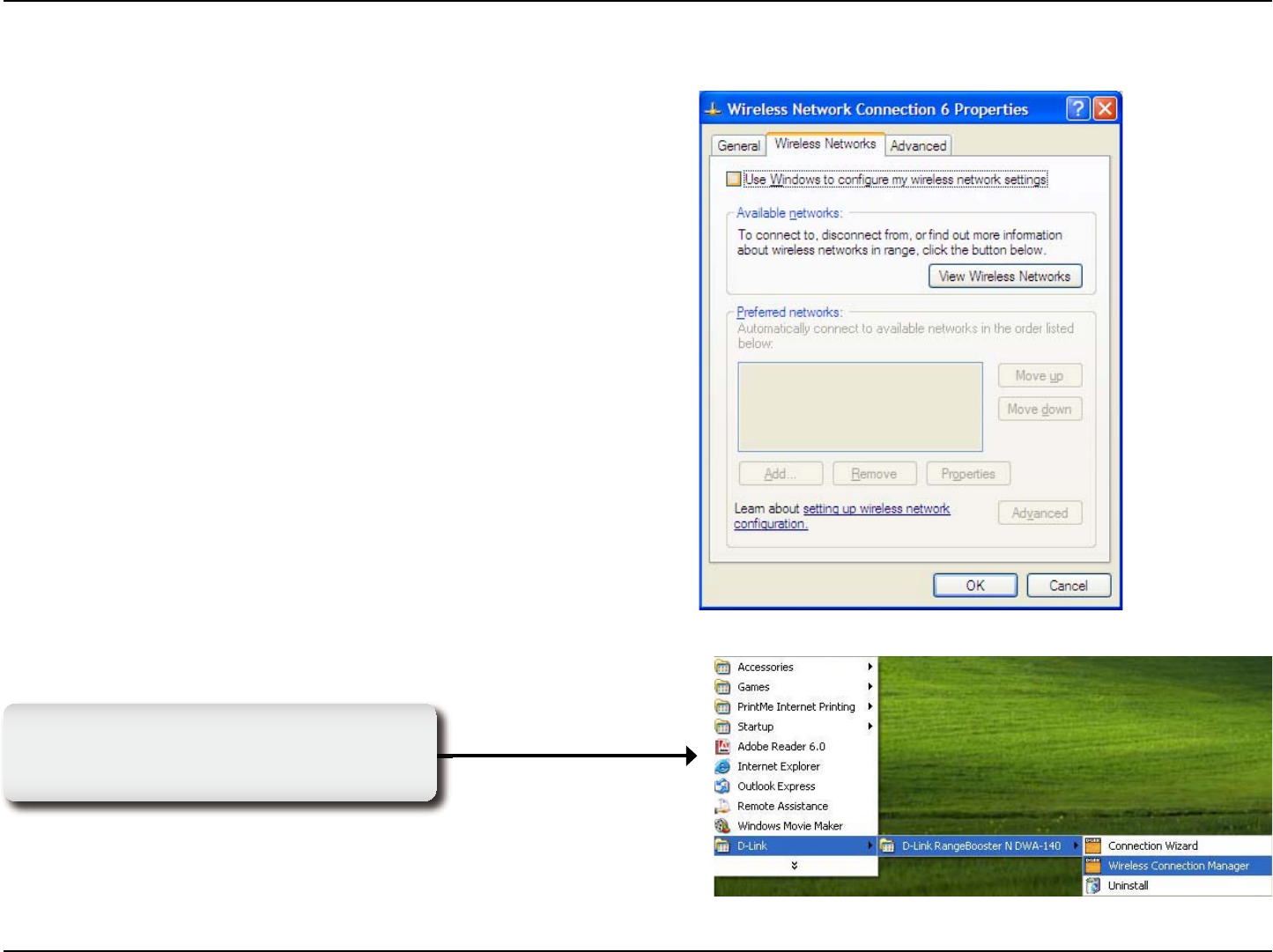
23D-Link DWA-140 User Manual
Section 3 - Configuration
In the Wireless Network Connection Properties window,
uncheck Use Windows® to configure my wireless network
settings and then click OK.
Click -> Start -> Programs -> D-Link
-> D-Link RangeBooster N DWA-140
-> Wireless Connection Manager

24D-Link DWA-140 User Manual
Section 4 - Wireless Security
Wireless Security
This section will show you the different levels of security you can use to protect your data from intruders. The
DWA-140 offers the following types of security:
• WPA2 (Wi-Fi Protected Access 2) • WPA2-PSK (Pre-Shared Key)
• WPA (Wi-Fi Protected Access) • WPA-PSK (Pre-Shared Key)
• WEP (Wired Equivalent Privacy) • 802.1x (RADIUS)
What is WEP?
WEP stands for Wired Equivalent Privacy. It is based on the IEEE 802.11 standard and uses the RC4 encryption
algorithm. WEP provides security by encrypting data over your wireless network so that it is protected as it is transmitted
from one wireless device to another.
To gain access to a WEP network, you must know the key. The key is a string of characters that you create. When
using WEP, you must determine the level of encryption. The type of encryption determines the key length. 128-bit
encryption requires a longer key than 64-bit encryption. Keys are dened by entering in a string in HEX (hexadecimal
- using characters 0-9, A-F) or ASCII (American Standard Code for Information Interchange – alphanumeric characters)
format. ASCII format is provided so you can enter a string that is easier to remember. The ASCII string is converted to
HEX for use over the network. Four keys can be dened so that you can change keys easily.

25D-Link DWA-140 User Manual
Section 4 - Wireless Security
What is WPA?
WPA, or Wi-Fi Protected Access, is a Wi-Fi standard that was designed to improve the security features of WEP (Wired
Equivalent Privacy).
The 2 major improvements over WEP:
• Improved data encryption through the Temporal Key Integrity Protocol (TKIP). TKIP scrambles the keys
using a hashing algorithm and, by adding an integrity-checking feature, ensures that the keys haven’t been
tampered with. WPA2 is based on 802.11i and uses Advanced Encryption Standard instead of TKIP.
• User authentication, which is generally missing in WEP, through the extensible authentication protocol
(EAP). WEP regulates access to a wireless network based on a computer’s hardware-specic MAC
address, which is relatively simple to be sniffed out and stolen. EAP is built on a more secure public-key
encryption system to ensure that only authorized network users can access the network.
WPA-PSK/WPA2-PSK uses a passphrase or key to authenticate your wireless connection. The key is an alpha-numeric
password between 8 and 63 characters long. The password can include symbols (!?*&_) and spaces. This key must
be the exact same key entered on your wireless router or access point.
WPA/WPA2 incorporates user authentication through the Extensible Authentication Protocol (EAP). EAP is built on a
more secure public key encryption system to ensure that only authorized network users can access the network.
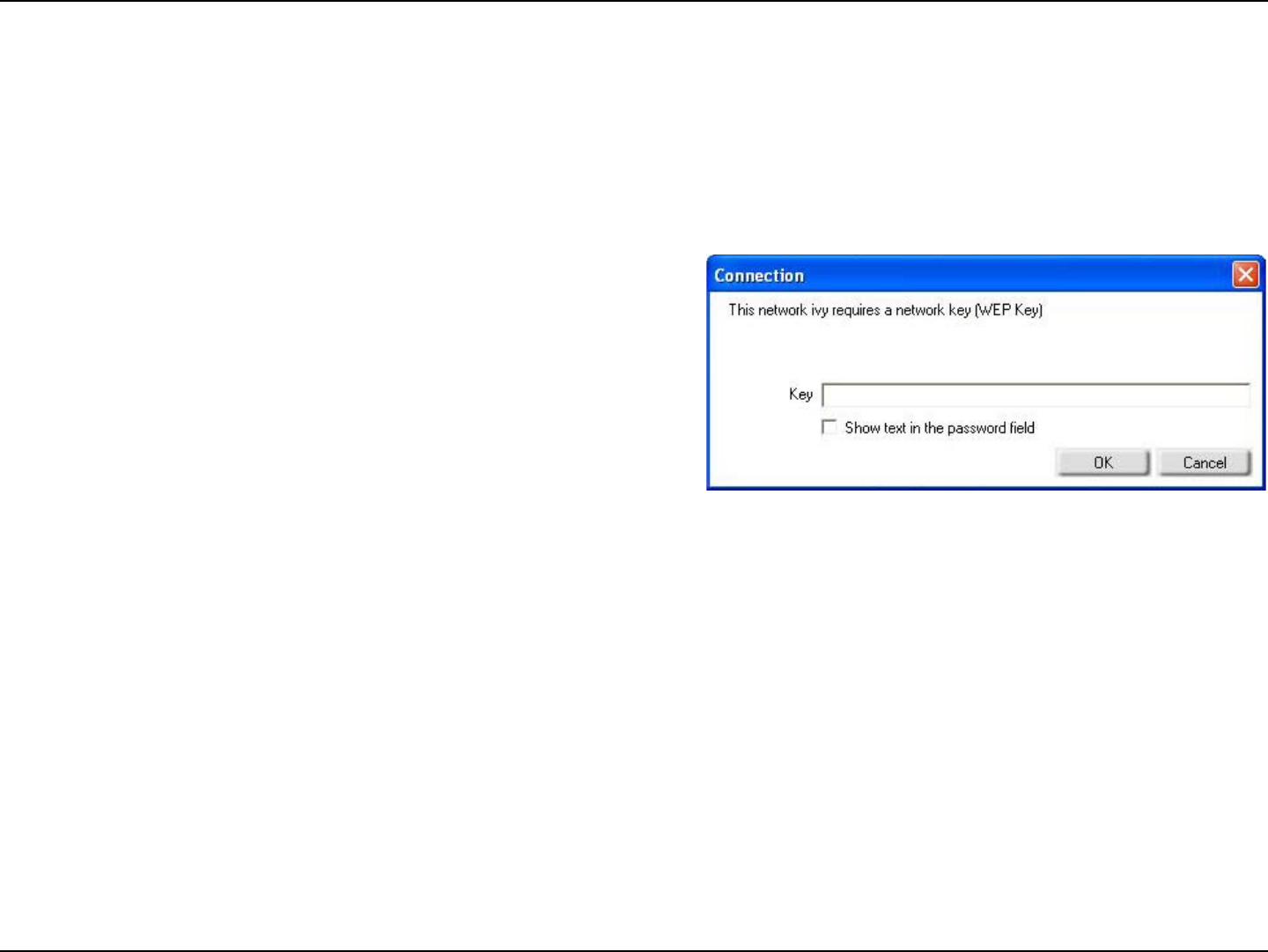
26D-Link DWA-140 User Manual
Section 4 - Wireless Security
Configure WEP
Using the D-Link Wireless Connection Manager
It is recommended to enable WEP on your wireless router or access point before conguring your wireless adapter. If
you are joining an existing network, you will need to know the WEP key being used.
1. Open the Wireless Connection Manager by double-clicking
on the D-Link icon on your desktop. From the list of available
wireless networks, select the network you want to connect to
can click Connect. If the network is using WEP, the screen (as
shown to the right) will appear.
2. Enter the WEP key exactly as it is on your wireless router or
access point.
3. Click the Show text in the password eld box to see the WEP key. Unchecking it will hide the key.
4. Click OK to connect to the network. Allow up to 30 seconds to connect.
If you would like to create a new network and enter the WEP settings, refer to the next page.
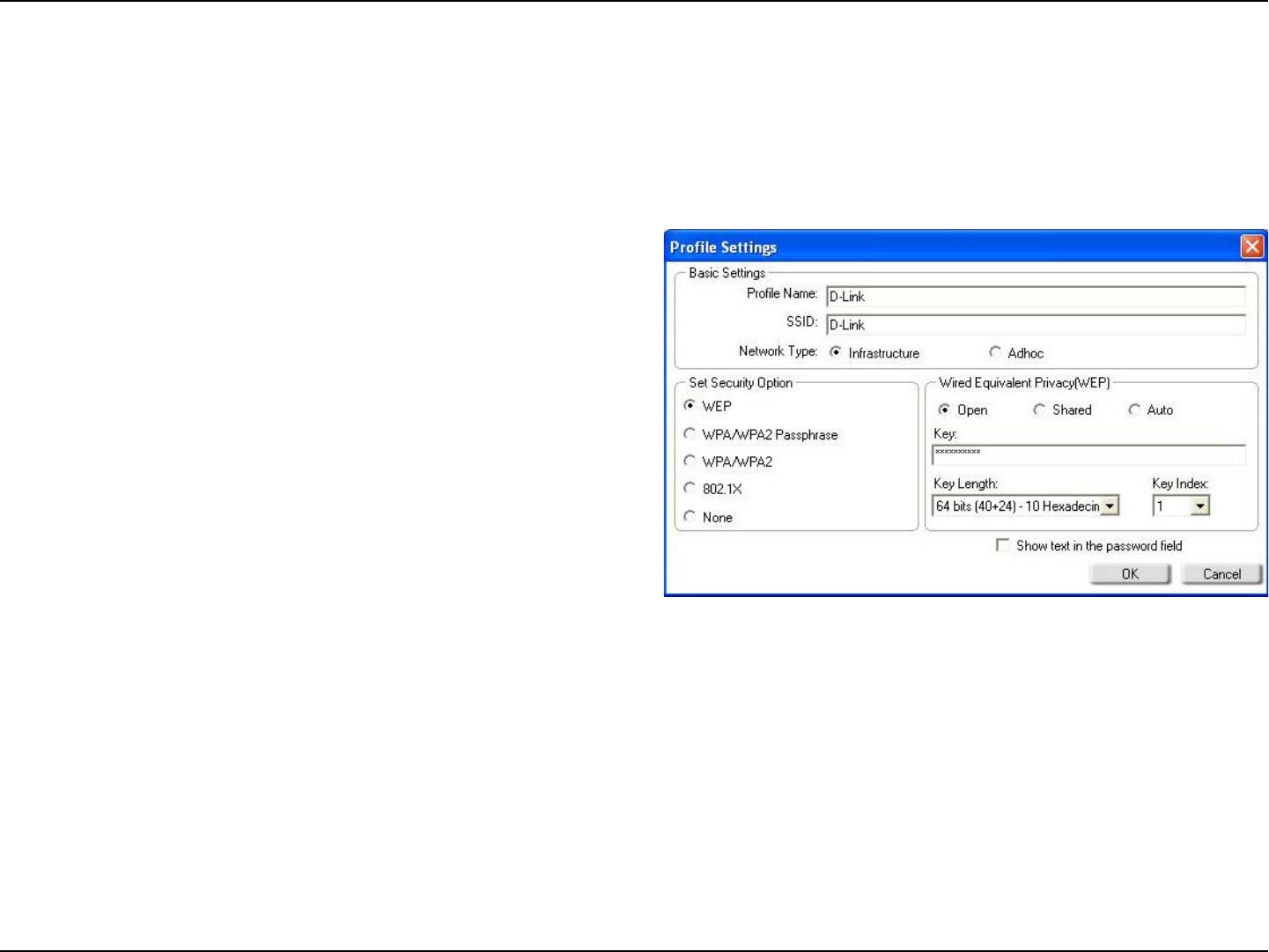
27D-Link DWA-140 User Manual
Section 4 - Wireless Security
It is recommended to enable WEP on your wireless router or access point before conguring your wireless adapter.
Make sure you enter the WEP key exactly the same on all wireless devices. It is strongly recommended to set the
authentication to Shared Key.
1. Open the Wireless Connection Manager by double-clicking on the D-Link icon on your desktop. Click on New to
create a new prole or highlight an existing prole and click Modify.
2. Select WEP under Set Security Option.
3. Select Shared and then select the Key Length from the
drop-down menu.
4. Enter the WEP key exactly as it is on your wireless router
or access point.
5. Click OK to connect to the network. Allow up to 30 seconds
to connect.
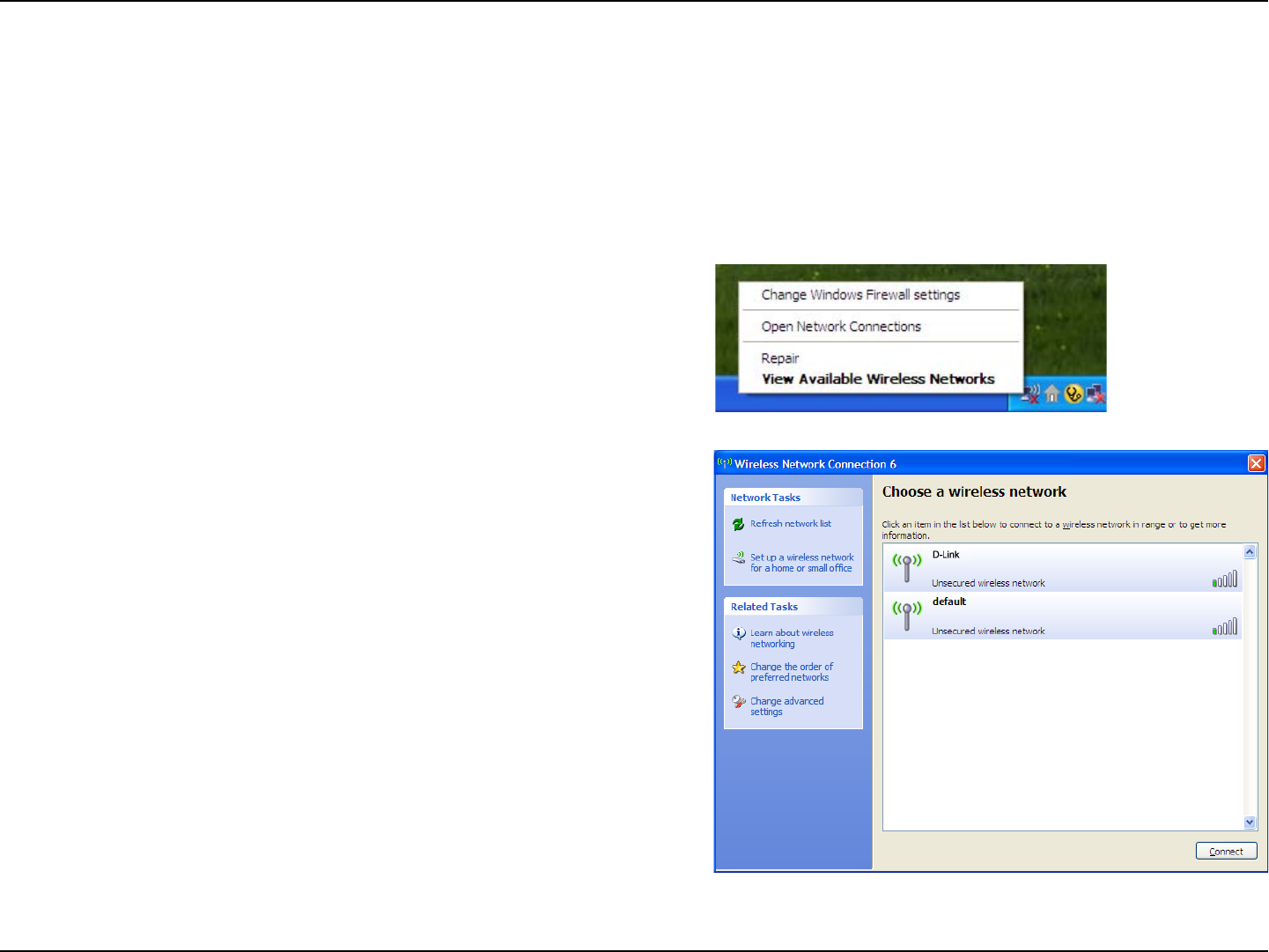
28D-Link DWA-140 User Manual
Section 4 - Wireless Security
Configure WEP
Using the Windows® XP Utility
It is recommended to enable WEP on your wireless router or access point before conguring your wireless adapter. If
you are joining an existing network, you will need to know the WEP key being used.
2. Highlight the wireless network (SSID) you would like to
connect to and click Connect.
1. Open the Windows® XP Wireless Utility by right-clicking
on the wireless computer icon in your system tray
(lower-right corner of screen). Select View Available
Wireless Networks.
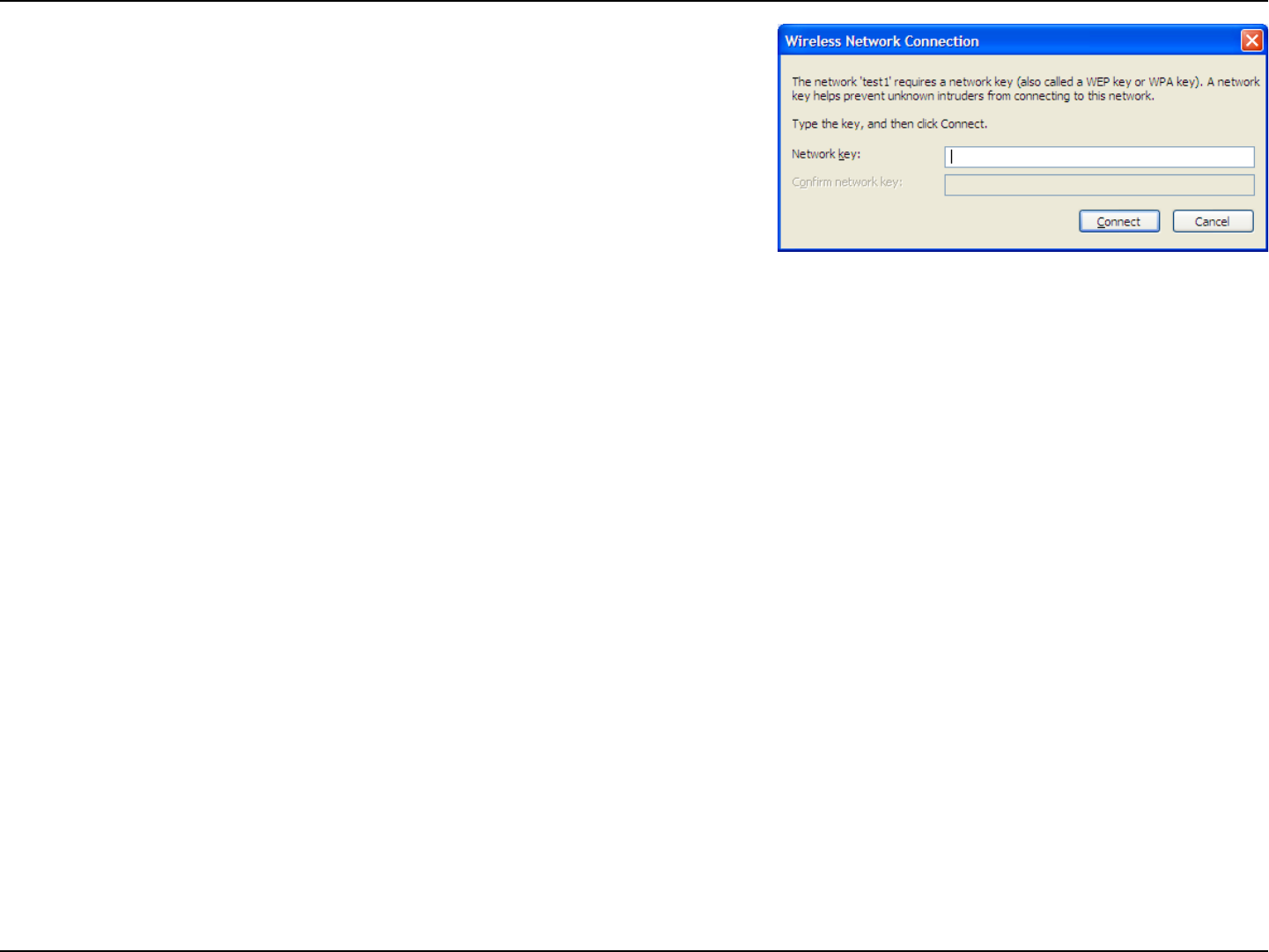
29D-Link DWA-140 User Manual
Section 4 - Wireless Security
3. The Wireless Network Connection box will appear. Enter the WEP
key and click Connect.
It may take 20-30 seconds to connect to the wireless network. If the
connection fails, please verify that the WEP settings are correct.
The WEP key must be exactly the same as on the wireless router or
access point.
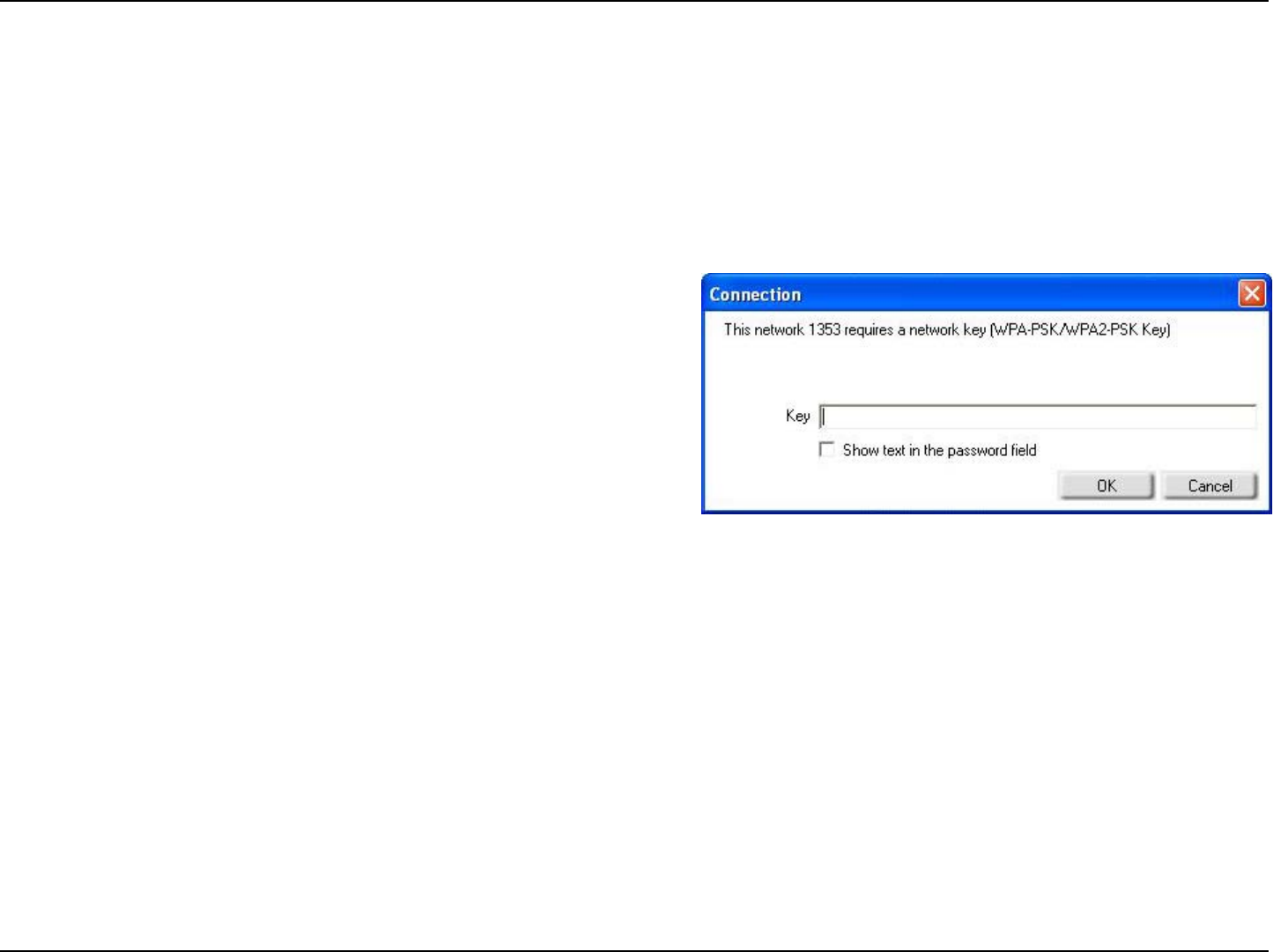
30D-Link DWA-140 User Manual
Section 4 - Wireless Security
Configure WPA/WPA2 Passphrase
Using the D-Link Wireless Connection Manager
It is recommended to enable WPA-PSK on your wireless router or access point before conguring your wireless adapter.
If you are joining an existing network, you will need to know the WPA-PSK passphrase being used.
1. Open the Wireless Connection Manager by double-clicking on
the D-Link icon on your desktop.
2. Highlight the wireless network (SSID) you would like to connect
to and click Connect. If the network is using WPA-PSK, the
screen (as shown to the left) will appear.
3. Enter the WPA-PSK passphrase exactly as it is on your wireless
router or access point. Click the Show text in the password
eld box to see the passphrase. Unchecking it will hide it.
4. Click OK to connect to the network. Allow up to 30 seconds to connect.
If you would like to create a new network and enter the WPA-PSK settings, refer to the next page.
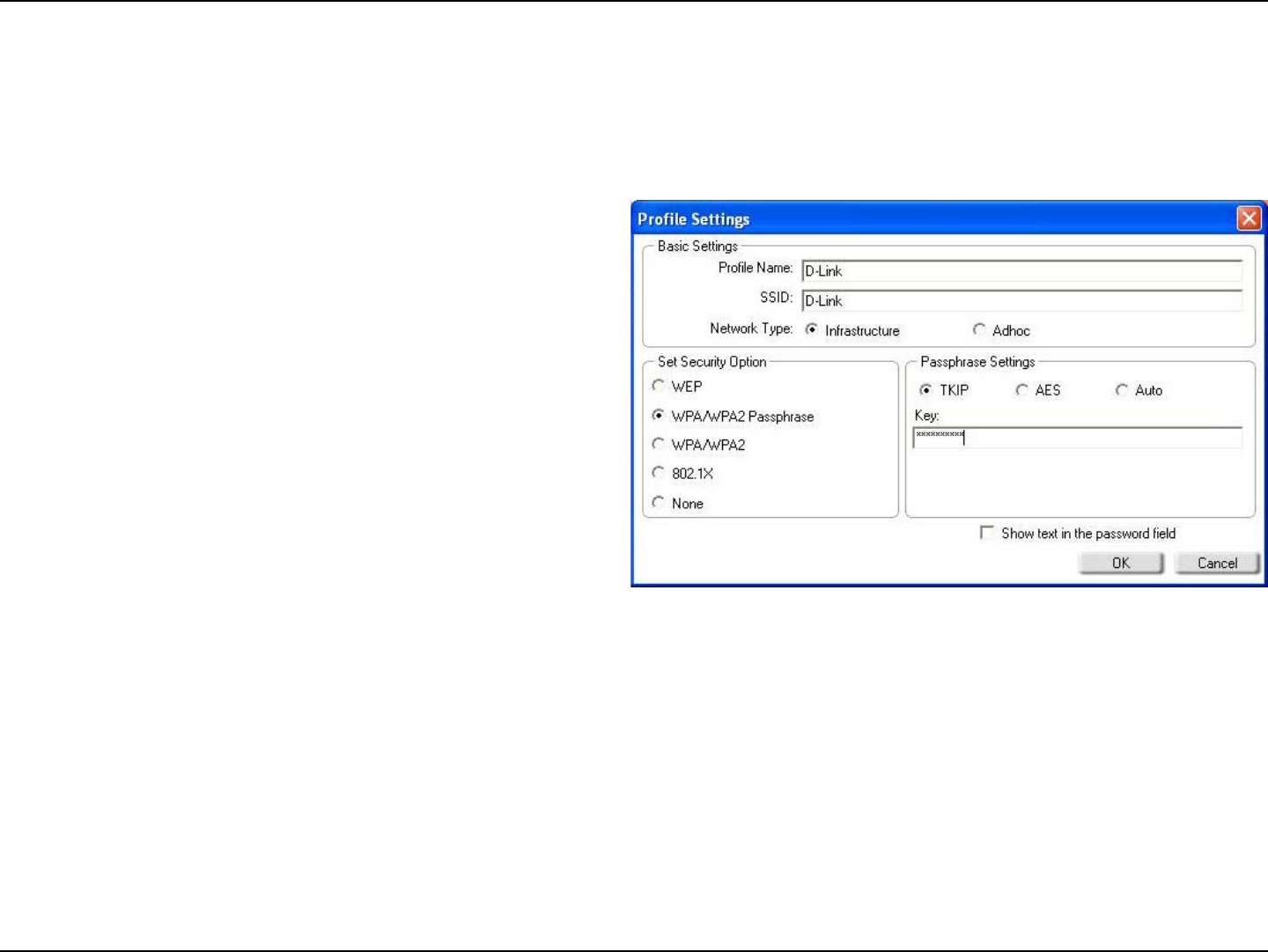
31D-Link DWA-140 User Manual
Section 4 - Wireless Security
It is recommended to enable WPA-PSK on your wireless router or access point before conguring your wireless adapter.
Make sure you enter the passphrase exactly the same on all wireless devices.
1. Open the Wireless Connection Manager by double-clicking on the D-Link icon on your desktop. Click on New to
create a new prole or highlight an existing prole and click Modify.
2. Select WPA/WPA2 Passphrase under Set Security
Option.
3. Select TKIP or AES.
4. Enter the passphrase exactly as it is on your wireless
router or access point.
5. Click OK to connect to the network. Allow up to 30
seconds to connect.
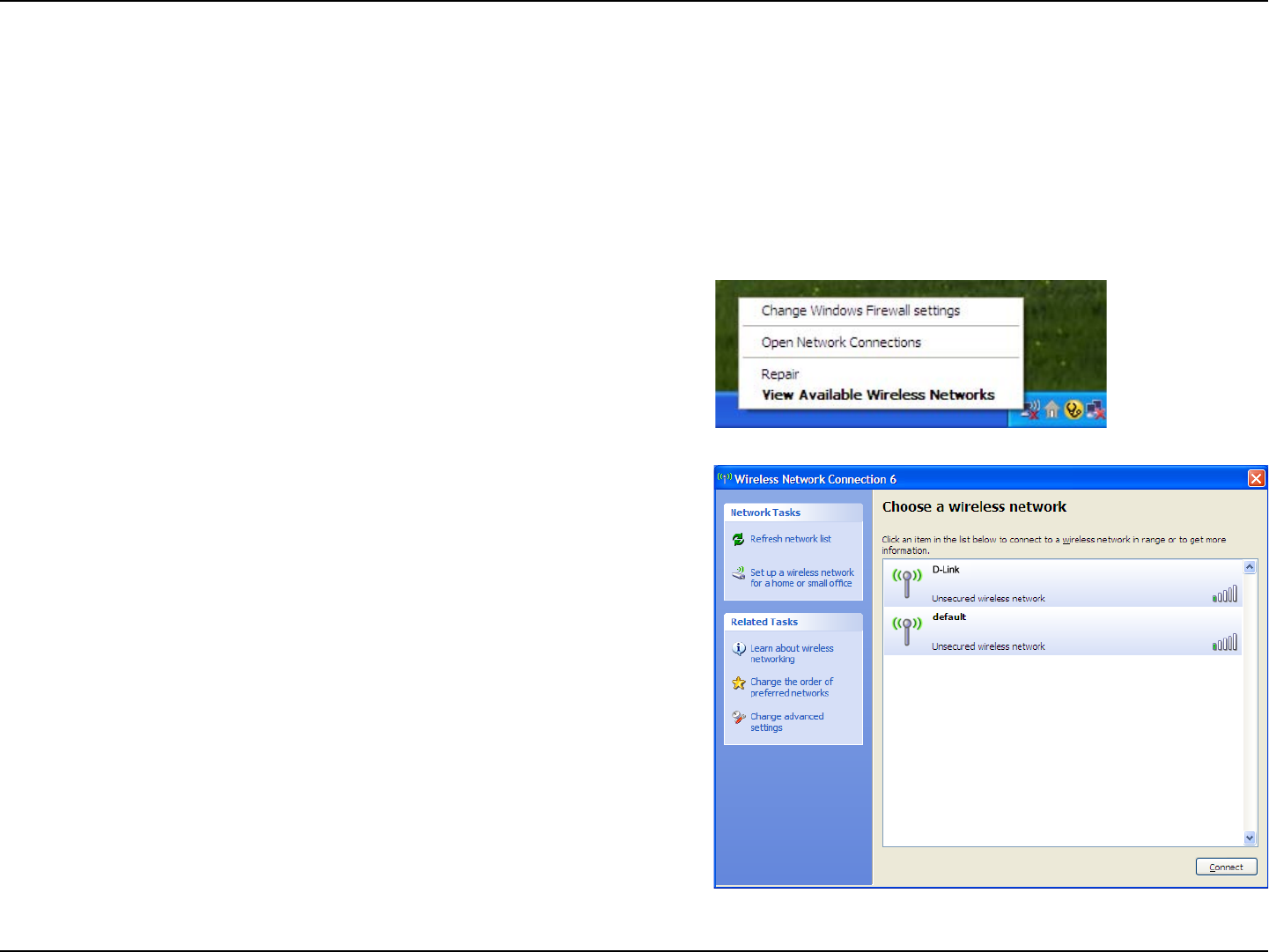
32D-Link DWA-140 User Manual
Section 4 - Wireless Security
Configure WPA/WPA2 Passphrase
Using the Windows® XP Utility
It is recommended to enable WPA-PSK on your wireless router or access point before conguring your wireless adapter.
If you are joining an existing network, you will need to know the WPA-PSK key being used.
2. Highlight the wireless network (SSID) you would like to
connect to and click Connect.
1. Open the Windows® XP Wireless Utility by right-clicking
on the wireless computer icon in your system tray
(lower-right corner of screen). Select View Available
Wireless Networks.
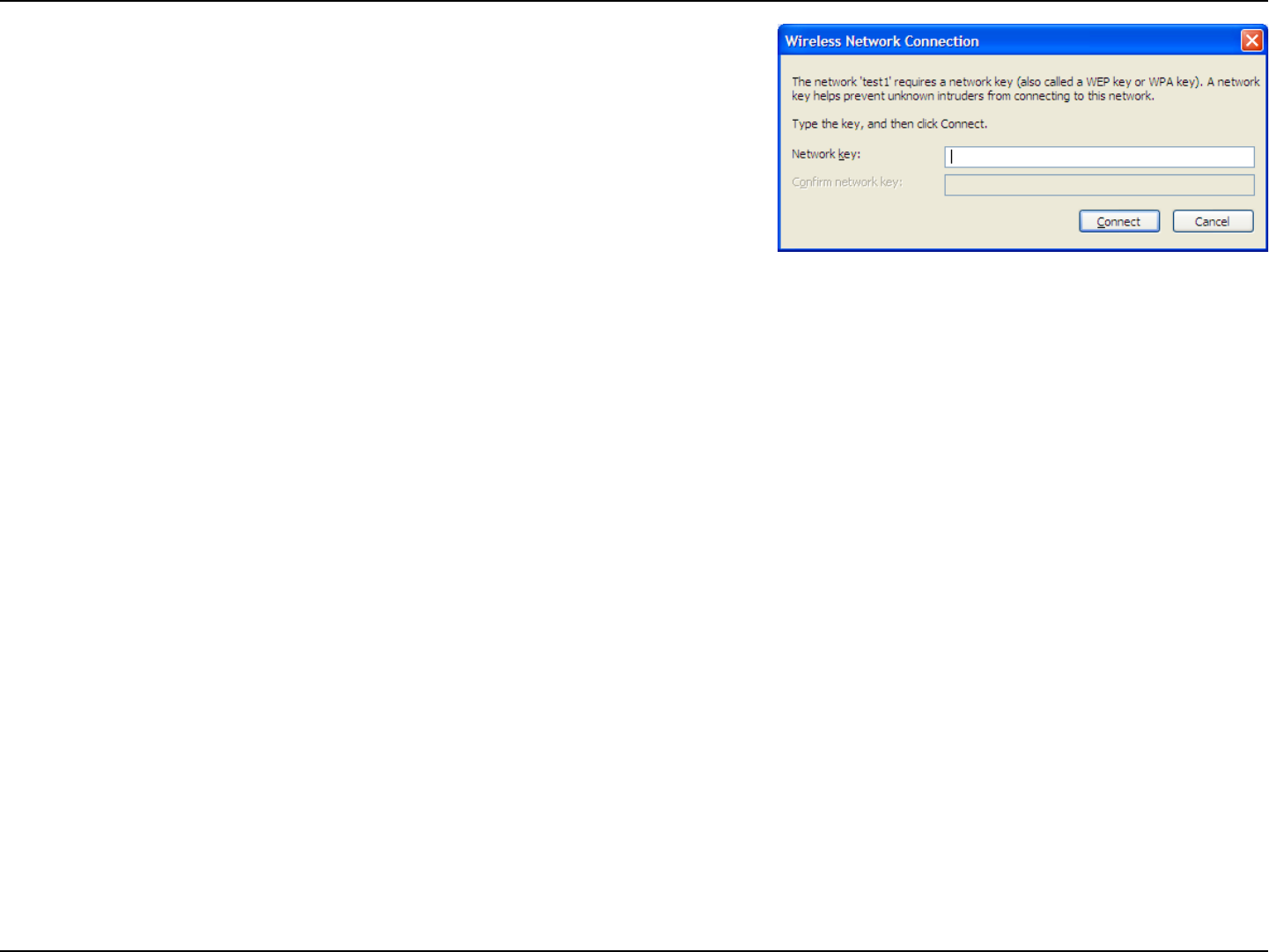
33D-Link DWA-140 User Manual
Section 4 - Wireless Security
3. The Wireless Network Connection box will appear. Enter the
WPA-PSK passphrase and click Connect.
It may take 20-30 seconds to connect to the wireless network. If the
connection fails, please verify that the WPA-PSK settings are correct.
The WPA-PSK passphrase must be exactly the same as on the
wireless router or access point.
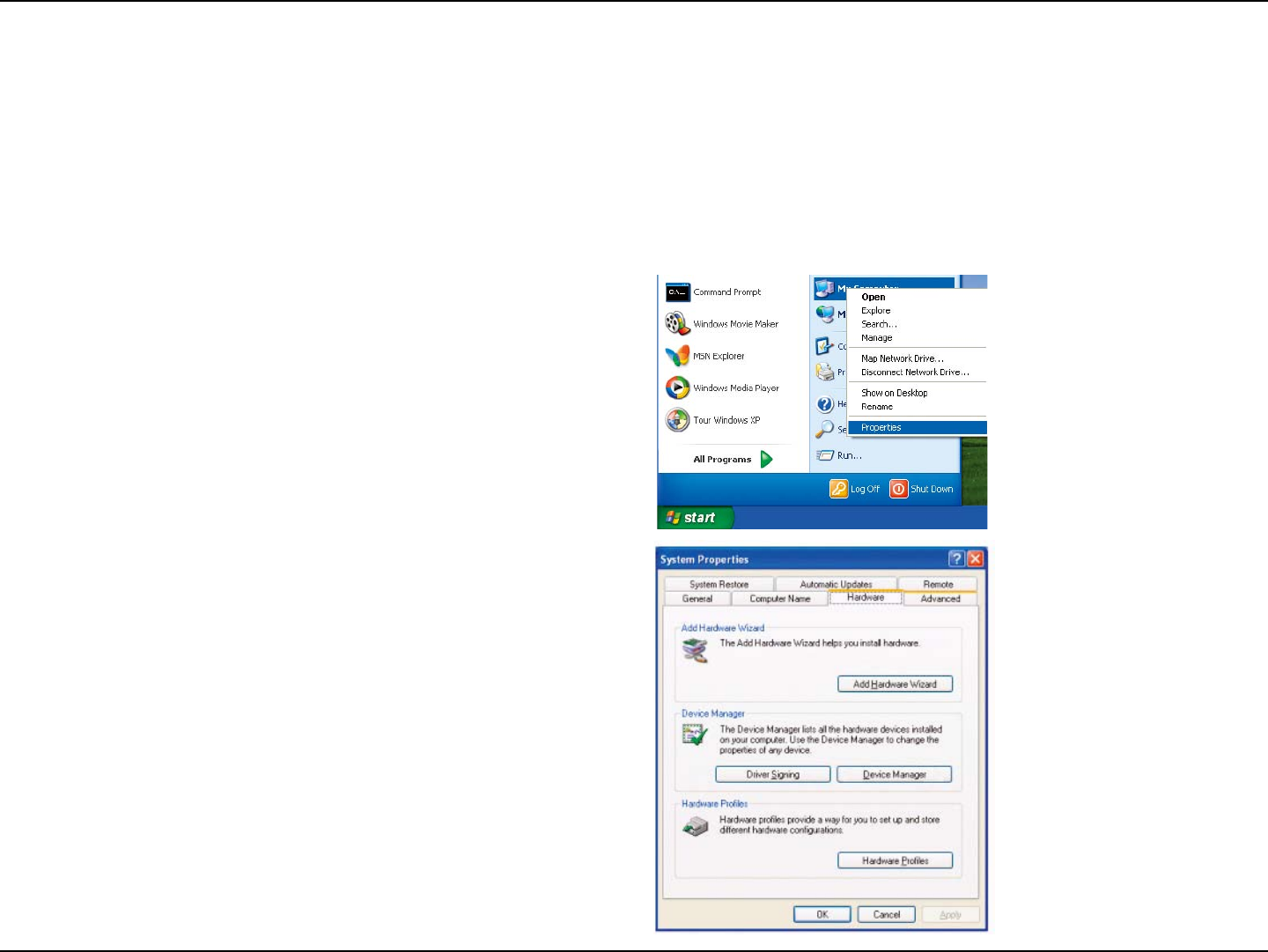
34D-Link DWA-140 User Manual
Section 5 - Troubleshooting
1. How do I know if my adapter is installed properly?
Select the Hardware Tab.
Troubleshooting
This chapter provides solutions to problems that can occur during the installation and operation of the DWA-130. Read
the following descriptions if you are having problems. (The examples below are illustrated in Windows® XP. If you
have a different operating system, the screenshots on your computer will look similar to the following examples.)
Go to Start > My Computer > Properties.
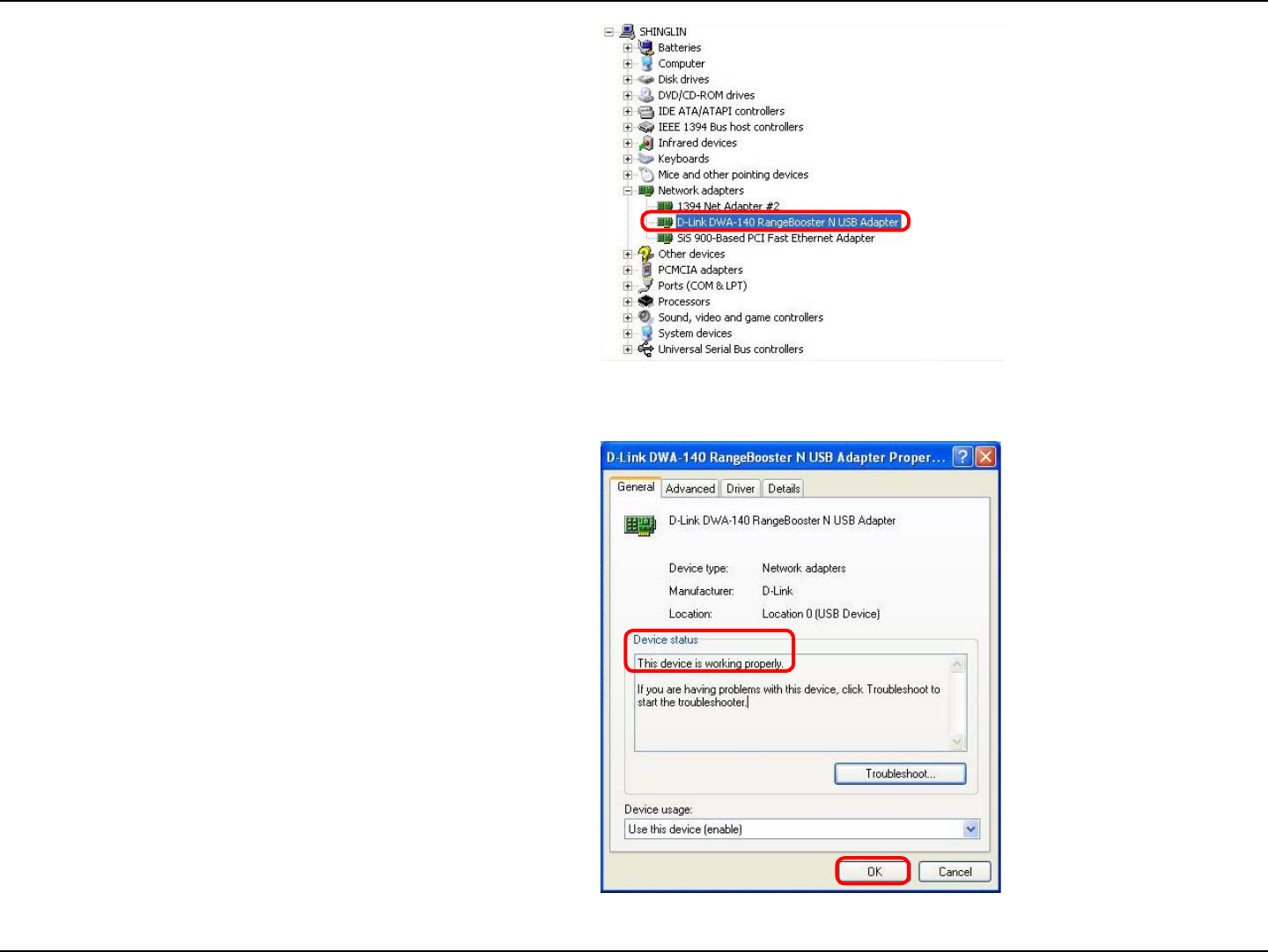
35D-Link DWA-140 User Manual
Section 5 - Troubleshooting
Click the + sign next to Network Adapters.
Right-click on D-Link DWA-140 USB Adapter.
Select Properties to check that the drivers are
installed properly.
Look under Device Status to check that the device
is working properly. Click OK to continue.

36D-Link DWA-140 User Manual
Section 5 - Troubleshooting
Make sure that the DWA-140 Wireless Adapter is properly seated in the computer’s USB port.
If Windows does not detect the hardware upon insertion of the adapter, make sure to completely remove drivers that
were previously loaded.
2. The computer does not recognize the DWA-140 Wireless Adapter.
• Check that the LED indicators for the broadband modem are indicating normal activity. If not, there may
be a problem with the broadband connection.
• Check that the LED indicators on the wireless router are functioning properly. If not, check that the AC
power and Ethernet cables are rmly connected.
• Check that the IP Address, subnet mask, gateway, and DNS settings are correctly entered for the
network
• In Infrastructure mode, make sure the same Service Set Identier (SSID) is specied on the settings
for the wireless clients and access points. The SSID factory default setting for D-Link products is default.
(Double-click on the WLAN icon in the taskbar. The Link Info screen will display the SSID setting.)
• In Ad-Hoc mode, both wireless clients will need to have the same SSID. Please note that it might be
necessary to set up one client to establish a BSS (Basic Service Set) and wait briey before setting
up other clients. This prevents several clients from trying to establish a BSS at the same time, which
can result in multiple singular BSSs being established, rather than a single BSS with multiple clients
associated to it.
3. The computer with the DWA-140 installed is unable to connect to the wireless network and/or the Internet.

37D-Link DWA-140 User Manual
Section 5 - Troubleshooting
Check that the Network Connection for the wireless client is congured properly. Select AP (Infrastructure) when
connecting to an access point and select Ad-Hoc mode when connecting without an access point. Double-click on
the WLAN icon in the taskbar > click on Conguration to change the settings for the wireless adapter.
If Security is enabled, make sure that the correct encryption keys are entered on both the DWA-130 and the access
point. Double-click on the WLAN icon in the taskbar > click Encryption. Check to see that the key selected is set to
the same key as other devices on the network.

38D-Link DWA-140 User Manual
Section 2 - Installation
Wireless Installation Considerations
The D-Link wireless adapter lets you access your network using a wireless connection from virtually anywhere within
the operating range of your wireless network. Keep in mind, however, that the number, thickness and location of
walls, ceilings, or other objects that the wireless signals must pass through, may limit the range. Typical ranges vary
depending on the types of materials and background RF (radio frequency) noise in your home or business. The key
to maximizing wireless range is to follow these basic guidelines:
1. Keep the number of walls and ceilings between the D-Link adapter and other network devices to a
minimum - each wall or ceiling can reduce your adapter’s range from 3-90 feet (1-30 meters.) Position
your devices so that the number of walls or ceilings is minimized.
2. Be aware of the direct line between network devices. A wall that is 1.5 feet thick (.5 meters), at a
45-degree angle appears to be almost 3 feet (1 meter) thick. At a 2-degree angle it looks over 42 feet
(14 meters) thick! Position devices so that the signal will travel straight through a wall or ceiling (instead
of at an angle) for better reception.
3. Building Materials make a difference. A solid metal door or aluminum studs may have a negative effect on
range. Try to position access points, wireless routers, and computers so that the signal passes through
drywall or open doorways. Materials and objects such as glass, steel, metal, walls with insulation, water
(sh tanks), mirrors, le cabinets, brick, and concrete will degrade your wireless signal.
4. Keep your product away (at least 3-6 feet or 1-2 meters) from electrical devices or appliances that
generate RF noise.
5. If you are using 2.4GHz cordless phones or X-10 (wireless products such as ceiling fans, lights, and
home security systems), your wireless connection may degrade dramatically or drop completely. Make
sure your 2.4GHz phone base is as far away from your wireless devices as possible. The base transmits
a signal even if the phone in not in use.

39D-Link DWA-140 User Manual
Appendix A - Wireless Basics
D-Link wireless products are based on industry standards to provide easy-to-use and compatible high-speed wireless
connectivity within your home, business or public access wireless networks. Strictly adhering to the IEEE standard,
the D-Link wireless family of products will allow you to securely access the data you want, when and where you want
it. You will be able to enjoy the freedom that wireless networking delivers.
A wireless local area network (WLAN) is a cellular computer network that transmits and receives data with radio signals
instead of wires. Wireless LANs are used increasingly in both home and ofce environments, and public areas such
as airports, coffee shops and universities. Innovative ways to utilize WLAN technology are helping people to work and
communicate more efciently. Increased mobility and the absence of cabling and other xed infrastructure have proven
to be benecial for many users.
Wireless users can use the same applications they use on a wired network. Wireless adapter cards used on laptop
and desktop systems support the same protocols as Ethernet adapter cards.
Under many circumstances, it may be desirable for mobile network devices to link to a conventional Ethernet LAN in
order to use servers, printers or an Internet connection supplied through the wired LAN. A Wireless Router is a device
used to provide this link.
Wireless Basics

40D-Link DWA-140 User Manual
Appendix A - Wireless Basics
What is Wireless?
Wireless or Wi-Fi technology is another way of connecting your computer to the network without using wires. Wi-Fi
uses radio frequency to connect wirelessly, so you have the freedom to connect computers anywhere in your home
or ofce network.
Why D-Link Wireless?
D-Link is the worldwide leader and award winning designer, developer, and manufacturer of networking products.
D-Link delivers the performance you need at a price you can afford. D-Link has all the products you need to build your
network.
How does wireless work?
Wireless works similar to how cordless phone work, through radio signals to transmit data from one point A to point
B. But wireless technology has restrictions as to how you can access the network. You must be within the wireless
network range area to be able to connect your computer. There are two different types of wireless networks Wireless
Local Area Network (WLAN), and Wireless Personal Area Network (WPAN).
Wireless Local Area Network (WLAN)
In a wireless local area network, a device called an Access Point (AP) connects computers to the network. The access
point has a small antenna attached to it, which allows it to transmit data back and forth over radio signals. With an
indoor access point as seen in the picture, the signal can travel up to 300 feet. With an outdoor access point the signal
can reach out up to 30 miles to serve places like manufacturing plants, industrial locations, college and high school
campuses, airports, golf courses, and many other outdoor venues.

41D-Link DWA-140 User Manual
Appendix A - Wireless Basics
Wireless Personal Area Network (WPAN)
Bluetooth is the industry standard wireless technology used for WPAN. Bluetooth devices in WPAN operate in a range
up to 30 feet away.
Compared to WLAN the speed and wireless operation range are both less than WLAN, but in return it doesn’t use
nearly as much power which makes it ideal for personal devices, such as mobile phones, PDAs, headphones, laptops,
speakers, and other devices that operate on batteries.
Who uses wireless?
Wireless technology as become so popular in recent years that almost everyone is using it, whether it’s for home,
ofce, business, D-Link has a wireless solution for it.
Home
• Gives everyone at home broadband access
• Surf the web, check email, instant message, and etc
• Gets rid of the cables around the house
• Simple and easy to use
Small Ofce and Home Ofce
• Stay on top of everything at home as you would at ofce
• Remotely access your ofce network from home
• Share Internet connection and printer with multiple computers
• No need to dedicate ofce space

42D-Link DWA-140 User Manual
Appendix A - Wireless Basics
Where is wireless used?
Wireless technology is expanding everywhere not just at home or ofce. People like the freedom of mobility and it’s
becoming so popular that more and more public facilities now provide wireless access to attract people. The wireless
connection in public places is usually called “hotspots”.
Using a D-Link USB Adapter with your laptop, you can access the hotspot to connect to Internet from remote locations
like: Airports, Hotels, Coffee Shops, Libraries, Restaurants, and Convention Centers.
Wireless network is easy to setup, but if you’re installing it for the rst time it could be quite a task not knowing where to
start. That’s why we’ve put together a few setup steps and tips to help you through the process of setting up a wireless
network.
Tips
Here are a few things to keep in mind, when you install a wireless network.
Centralize your router or Access Point
Make sure you place the router/access point in a centralized location within your network for the best performance. Try
to place the router/access point as high as possible in the room, so the signal gets dispersed throughout your home.
If you have a two-story home, you may need a repeater to boost the signal to extend the range.
Eliminate Interference
Place home appliances such as cordless telephones, microwaves, and televisions as far away as possible from the
router/access point. This would signicantly reduce any interference that the appliances might cause since they operate
on same frequency.

43D-Link DWA-140 User Manual
Appendix A - Wireless Basics
Security
Don’t let you next-door neighbors or intruders connect to your wireless network. Secure your wireless network by turning
on the WPA or WEP security feature on the router. Refer to product manual for detail information on how to set it up.
There are basically two modes of networking:
• Infrastructure – All wireless clients will connect to an access point or wireless router.
• Ad-Hoc – Directly connecting to another computer, for peer-to-peer communication, using wireless
network adapters on each computer, such as two or more DWA-130 wireless network USB Adapters.
An Infrastructure network contains an Access Point or wireless router. All the wireless devices, or clients, will connect
to the wireless router or access point.
An Ad-Hoc network contains only clients, such as laptops with wireless USB Adapters. All the adapters must be in
Ad-Hoc mode to communicate.
Wireless Modes
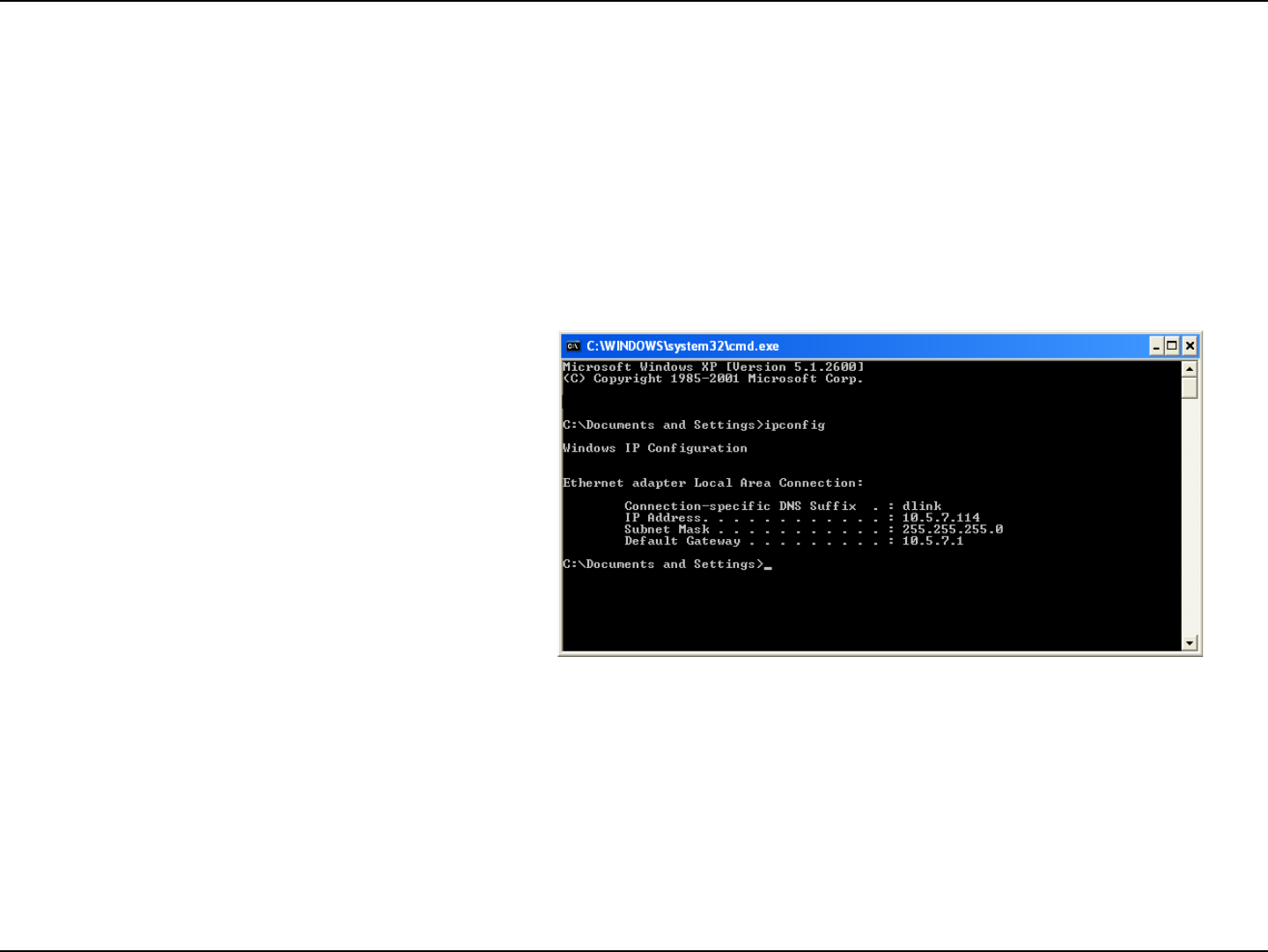
44D-Link DWA-140 User Manual
Appendix B - Networking Basics
Networking Basics
Check your IP address
After you install your new D-Link adapter, by default, the TCP/IP settings should be set to obtain an IP address from
a DHCP server (i.e. wireless router) automatically. To verify your IP address, please follow the steps below.
Click on Start > Run. In the run box type cmd and click OK.
At the prompt, type ipconfig and press Enter.
This will display the IP address, subnet mask, and
the default gateway of your adapter.
If the address is 0.0.0.0, check your adapter
installation, security settings, and the settings
on your router. Some rewall software programs
may block a DHCP request on newly installed
adapters.
If you are connecting to a wireless network at a
hotspot (e.g. hotel, coffee shop, airport), please contact an employee or administrator to verify their wireless network
settings.
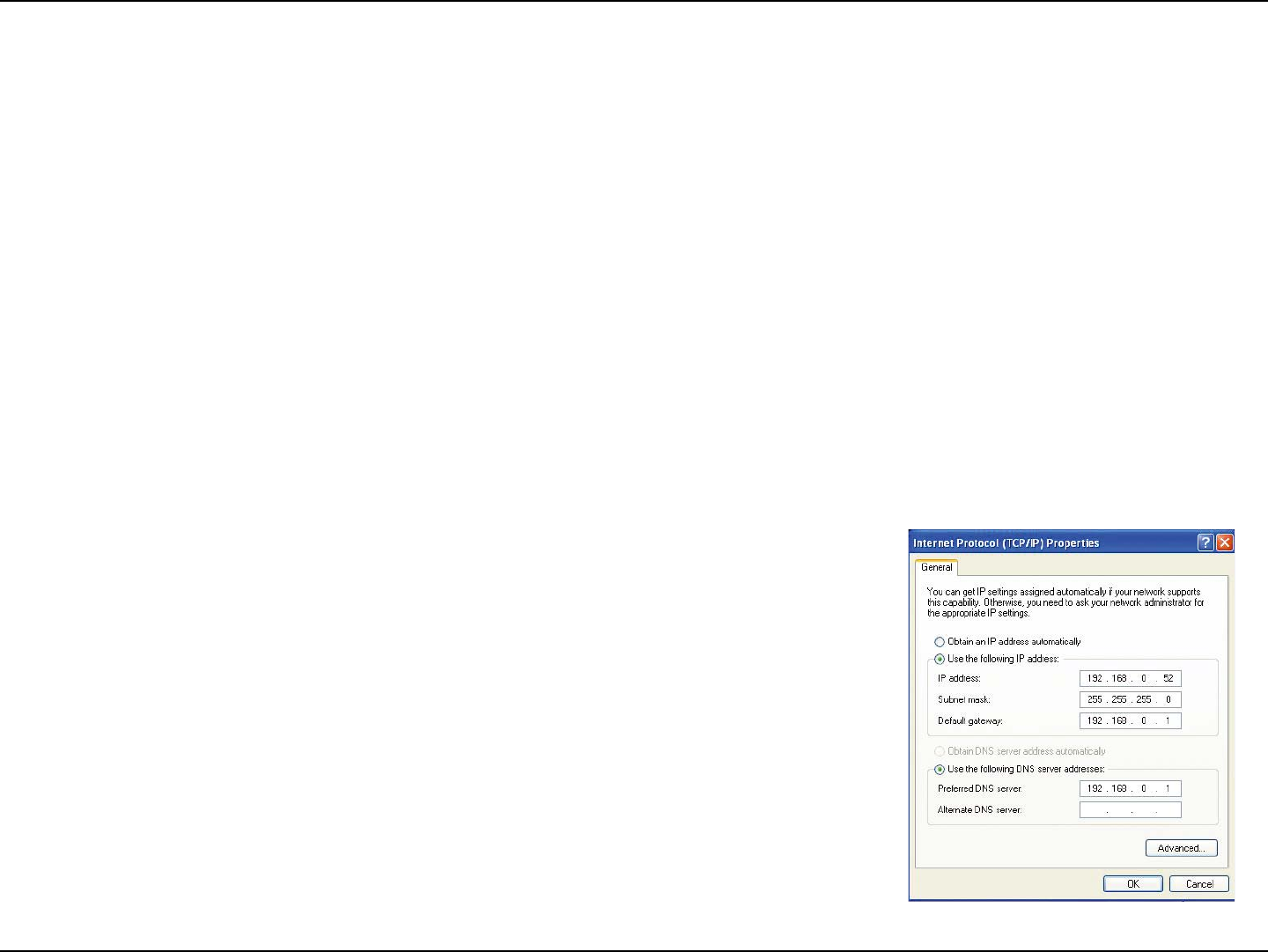
45D-Link DWA-140 User Manual
Appendix B - Networking Basics
Statically Assign an IP address
If you are not using a DHCP capable gateway/router, or you need to assign a static IP address, please follow the steps
below:
Step 1
Windows® XP - Click on Start > Control Panel > Network Connections.
Windows® 2000 - From the desktop, right-click My Network Places > Properties.
Step 2
Right-click on the Local Area Connection which represents your D-Link network adapter and select Properties.
Step 3
Highlight Internet Protocol (TCP/IP) and click Properties.
Step 4
Click Use the following IP address and enter an IP address that is on the same subnet as your network or the LAN
IP address on your router.
Example: If the router´s LAN IP address is 192.168.0.1, make your IP address
192.168.0.X where X is a number between 2 and 99. Make sure that the number
you choose is not in use on the network. Set Default Gateway the same as the LAN
IP address of your router (192.168.0.1).
Set Primary DNS the same as the LAN IP address of your router (192.168.0.1). The
Secondary DNS is not needed or you may enter a DNS server from your ISP.
Step 5
Click OK twice to save your settings.

46D-Link DWA-140 User Manual
Appendix C - Technical Specifications
Technical Specifications
SYSTEM REQUIREMENTS
• Windows Vista / XP SP2 or 2000 SP4
• CD-ROM drive
• 20MB hard disk space
• Available USB port
STANDARDS
• IEEE 802.11n (draft)
• IEEE 802.11g
• IEEE 802.11b
• USB 2.0
FREQUENCY RANGE
• 2412 to 2462MHz (North America)
• 72412 to 2472MHz (General Europe)
EMISSION SCHEMES
• DSSS, OFDM
DATA MODULATION SCHEMES
DBPSK, DQPSK, CCK and OFDM
(BPSK/QPSK/16-QAM/64-QAM)
DATA RATES 1
• 802.11g: 6/9/12/18/24/36/48/54Mbps
• 802.11b: 1/2/5.5/11Mbps
• 802.11n: 30/60/90/120/180/240/270/300Mbps
TRANSMIT OUTPUT POWER (typical)
• 18dbm (802.11 b)
• 14dbm (802.11 g/n)
ANTENNAS
• Two integrated antennas
SECURITY
• 64/128-bit WEP data encryption
• Wi-Fi Protected Access (WPA, WPA2)
OPERATING VOLTAGE
5VDC +/- 10%
POWER CONSUMPTION (802.11n)
• TX: 460mA
• RX: 240mA
DIAGNOSTIC LEDS
• Activity
Dimensions
87 x 28 x 12 mm
Operating Temperature
0º to 40º C
Storage Temperature
-20º to 65º C
Operating Humidity
10% to 90% non-condensing
Storage Humidity
5% to 95% non-condensing
Certications
• FCC Class B
• CE
• C-Tick
• IC
2412 to 2472MHz (General Europe)

47D-Link DWA-140 User Manual
Appendix C - Technical Specifications
Dimensions
• L = 4.64 (114.3mm)
• W = 2.13 (54mm)
• H = 0.34 inches (8.7mm)
* Maximum wireless signal rate derived from IEEE Standard 802.11g specications. Actual data throughput will vary. Network conditions and
environmental factors, including volume of network trafc, building materials and construction, and network overhead, lower actual data throughput
rate. Environmental factors will adversely affect wireless signal range.

FCC Statement: Federal Communication Commission Interference Statement
This equipment has been tested and found to comply with the limits for a Class B digital device, pursuant
to Part 15 of the FCC Rules. These limits are designed to provide reasonable protection against harmful
interference in a residential installation. This equipment generates, uses and can radiate radio frequency
energy and, if not installed and used in accordance with the instructions, may cause harmful interference
to radio communications. However, there is no guarantee that interference will not occur in a particular
installation. If this equipment does cause harmful interference to radio or television reception, which can
be determined by turning the equipment off and on, the user is encouraged to try to correct the
interference by one of the following measures:
● Reorient or relocate the receiving antenna.
● Increase the separation between the equipment and receiver.
● Connect the equipment into an outlet on a circuit different from that to which the receiver is
connected.
● Consult the dealer or an experienced radio/TV technician for help.
FCC Caution: Any changes or modifications not expressly approved by the party responsible for
compliance could void the user’s authority to operate this equipment.
This device complies with Part 15 of the FCC Rules. Operation is subject to the following two conditions: (1) This
device may not cause harmful interference, and (2) this device must accept any interference received, including
interference that may cause undesired operation.
This device and its antenna(s) must not be co-located or operation in conjunction with any other antenna
or transmitter.
IMPORTANT NOTE:
Federal Communication Commission (FCC) Radiation Exposure Statement
This EUT is compliance with SAR for general population/uncontrolled exposure limits in ANSI/IEEE
C95.1-1999 and had been tested in accordance with the measurement methods and procedures specified
in OET Bulletin 65 Supplement C.
IC Statement:
Operation is subject to the following two conditions: (1) this device may not cause interference, and (2) this
device must accept any interference, including interference that may cause undesired operation of the
device.
For product available in the USA/Canada market, only channel 1~11 can be operated. Selection of other
channels is not possible.
This device and its antenna(s) must not be co-located or operation in conjunction with any other antenna
or transmitter.
CE Statement: 0560
Hereby, D-Link, declares that this device is in compliance with the essential requirement and other relevant
provisions of the R&TTE Driective 1999/5/EC.
This device will be sold in the following EEA countries:Austria, Italy, Belgium, Liechtenstein, Denmark,
Luxembourg, Finland, Netherlands, France, Norway, Germany, Portugal, Greece, Spain, Iceland, Sweden,
Ireland, United Kingdom, Cyprus, Czech Republic, Estonia, Hungary, Latvia, Lithuania, Malta, Slovakia,
Poland, Slovenia. Bulgaria. Romania